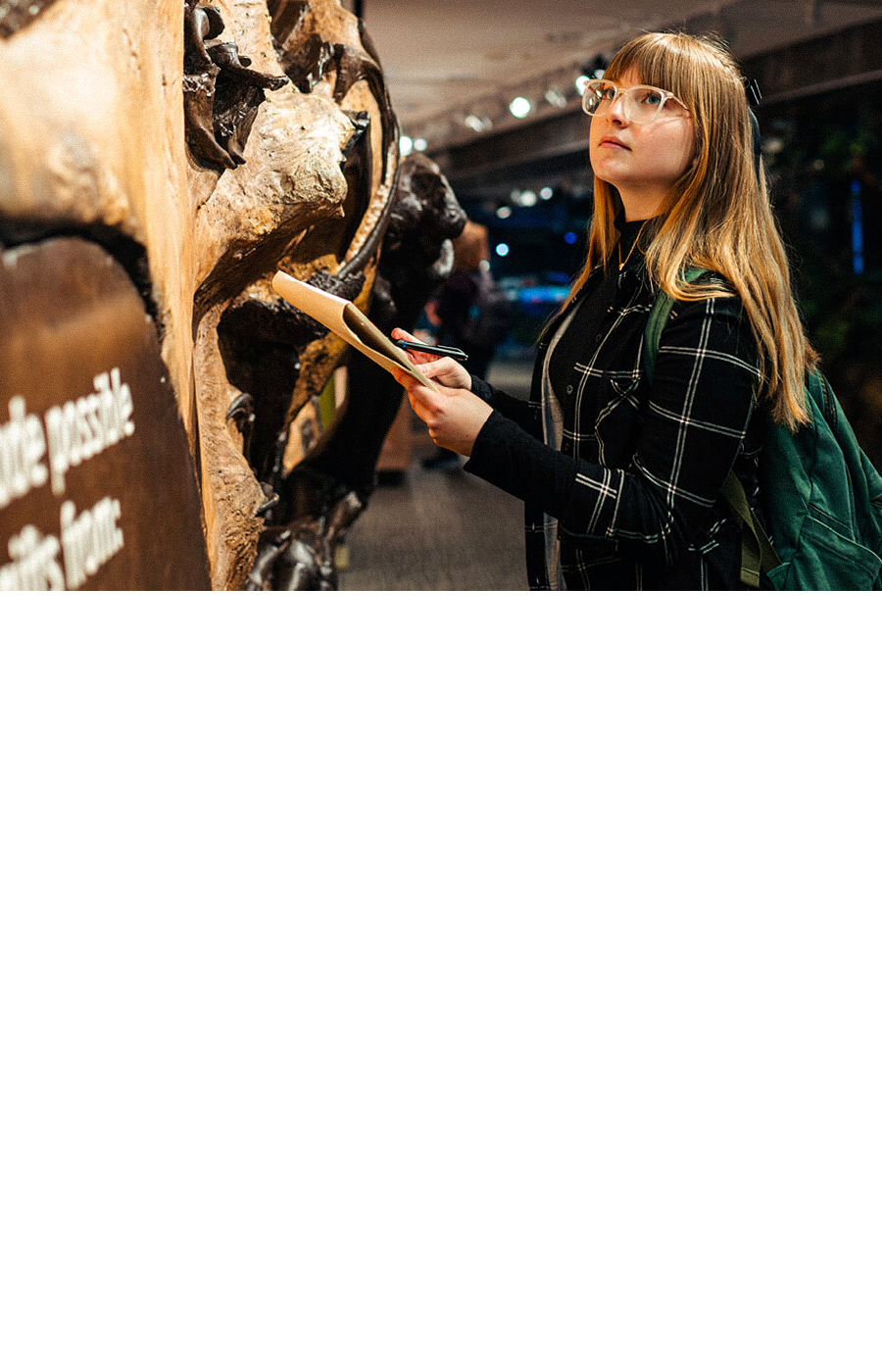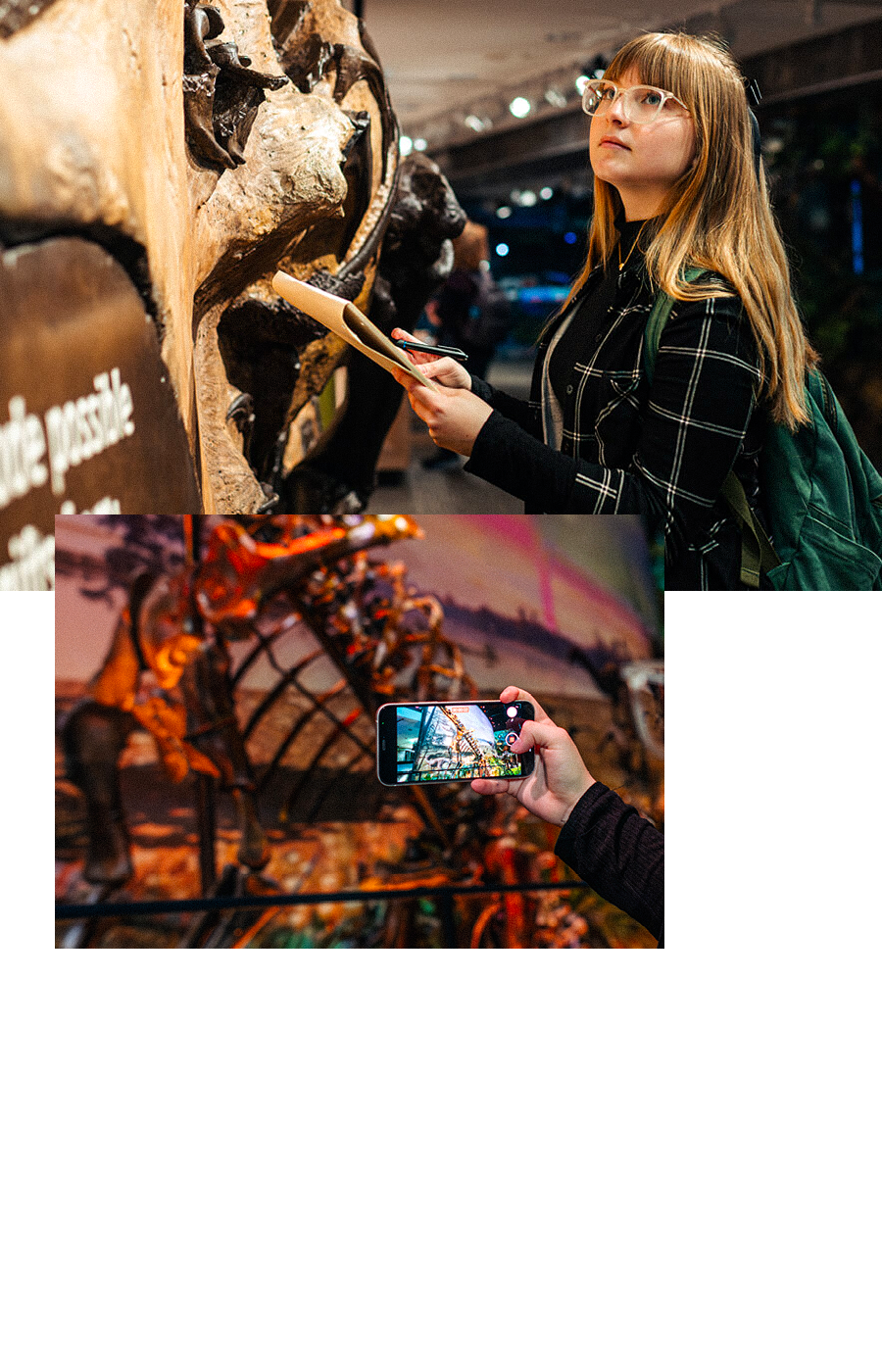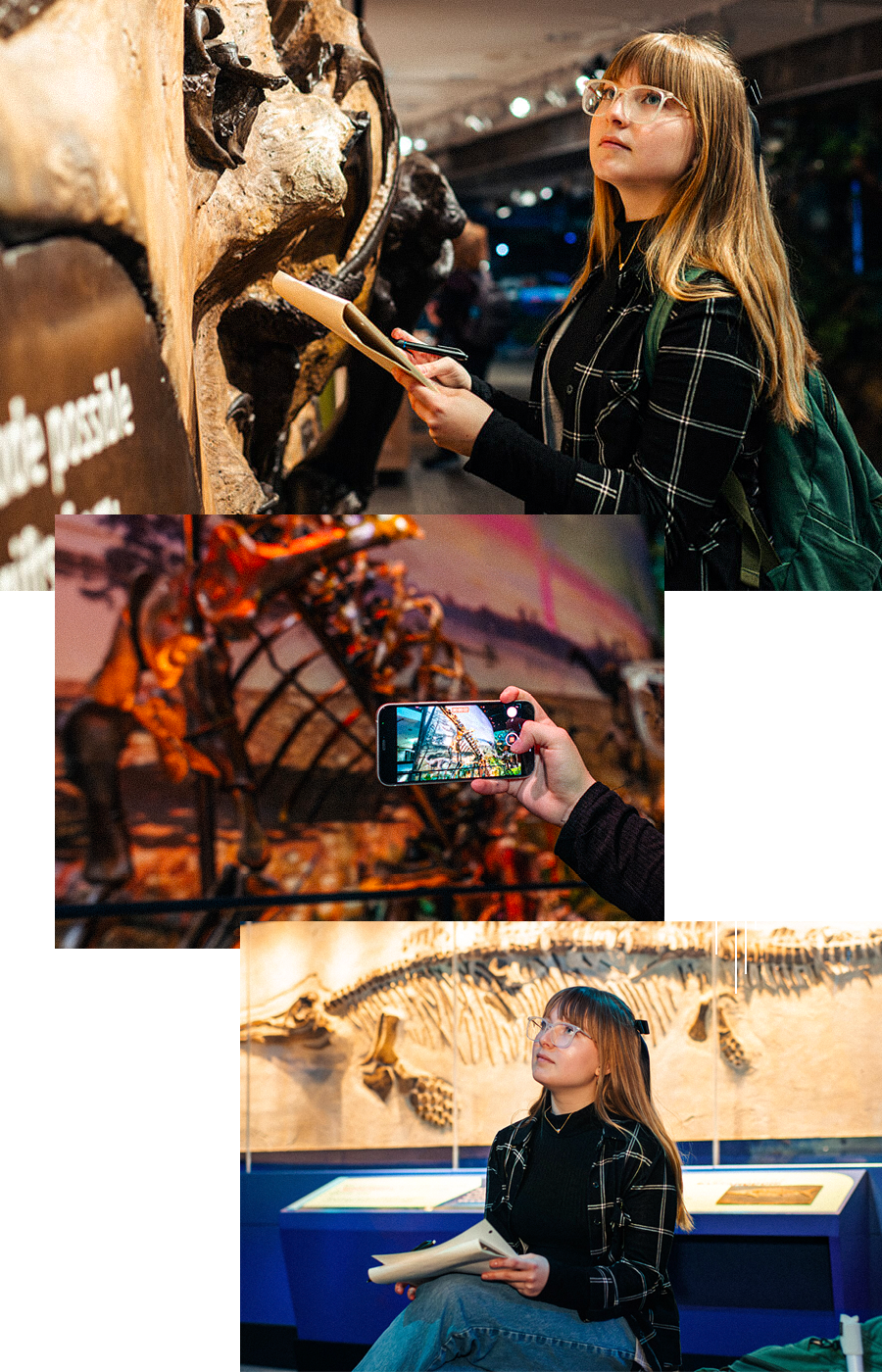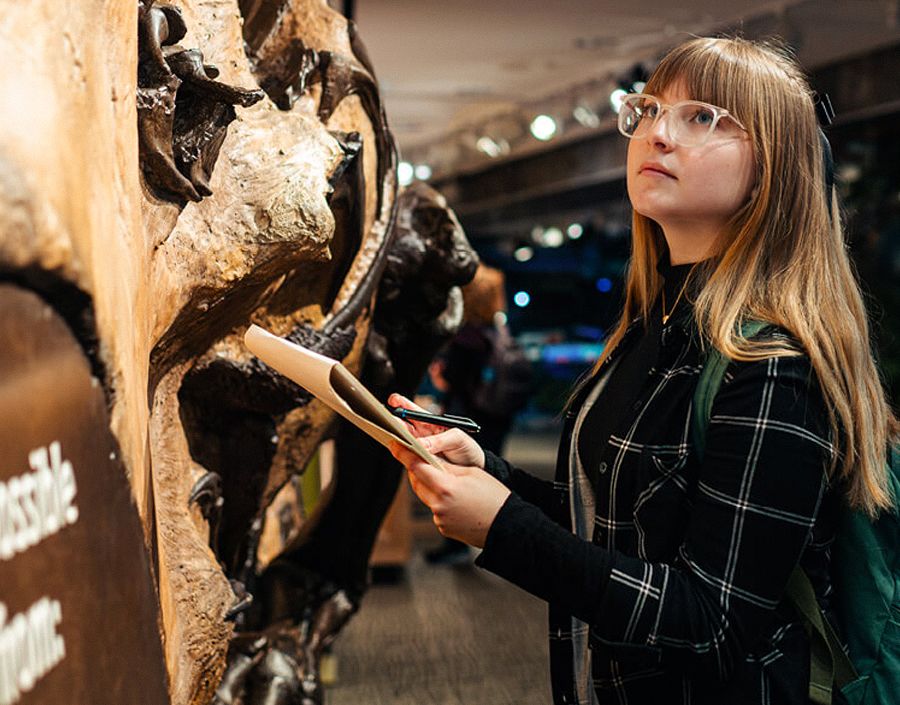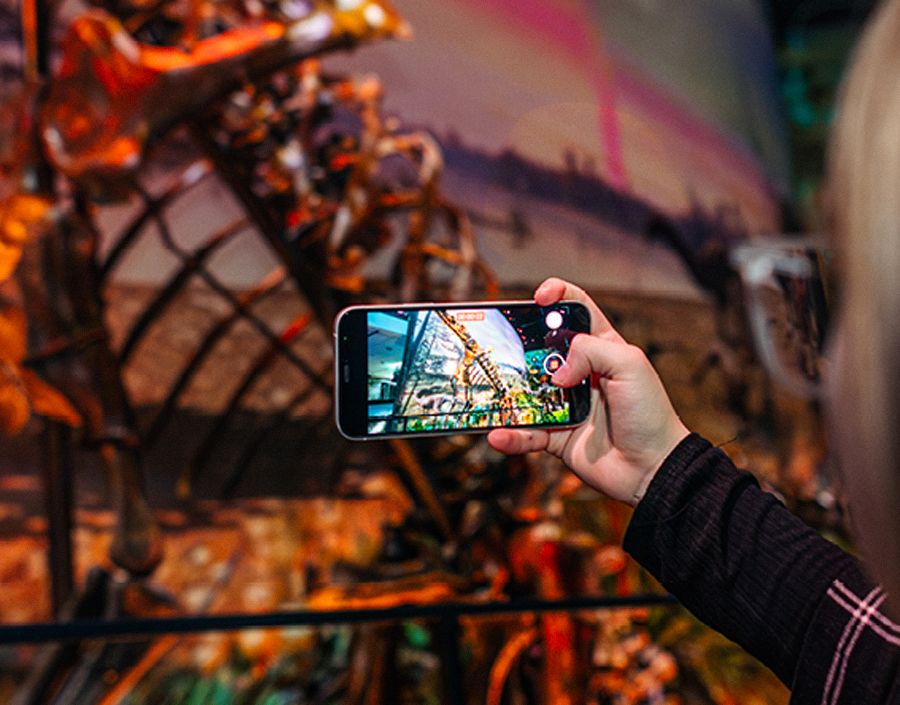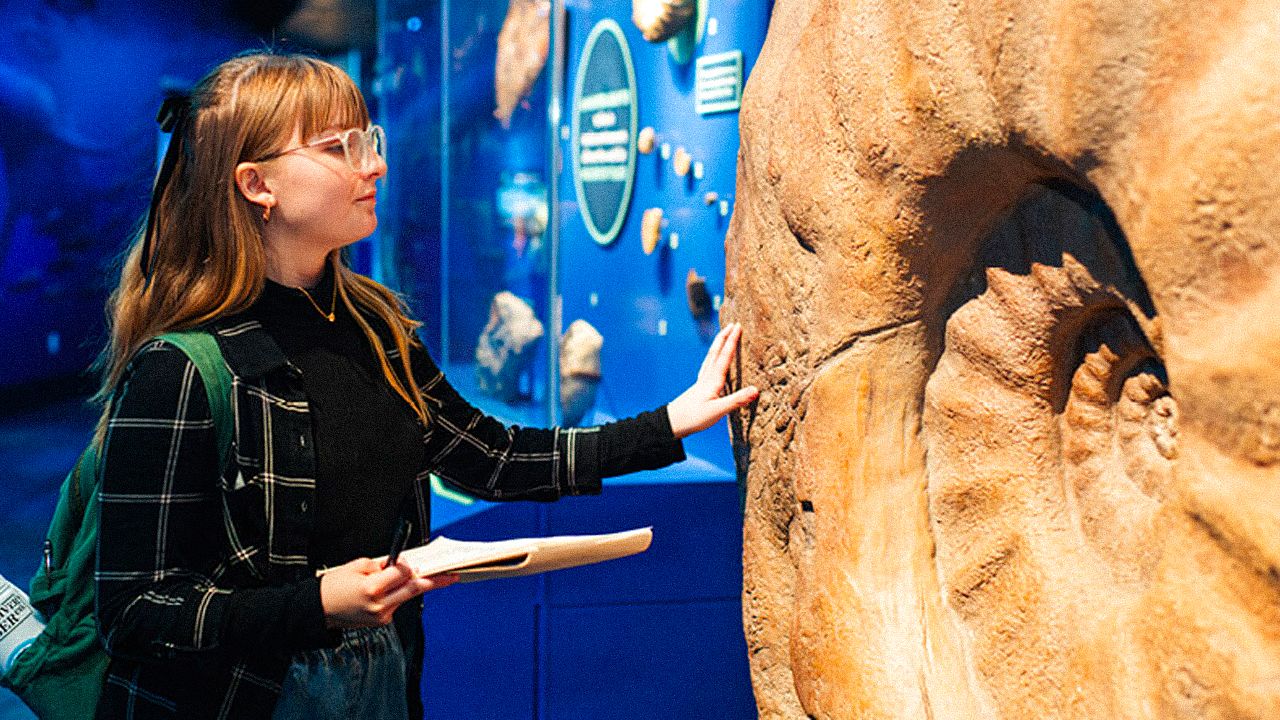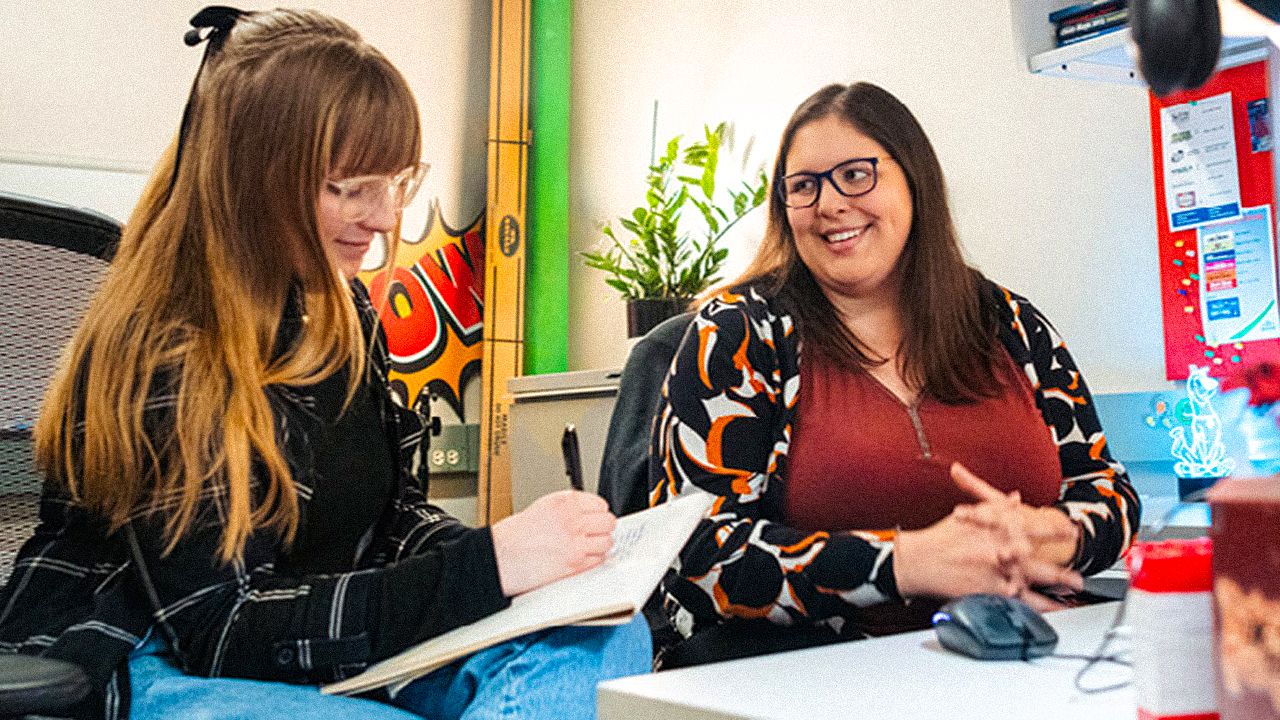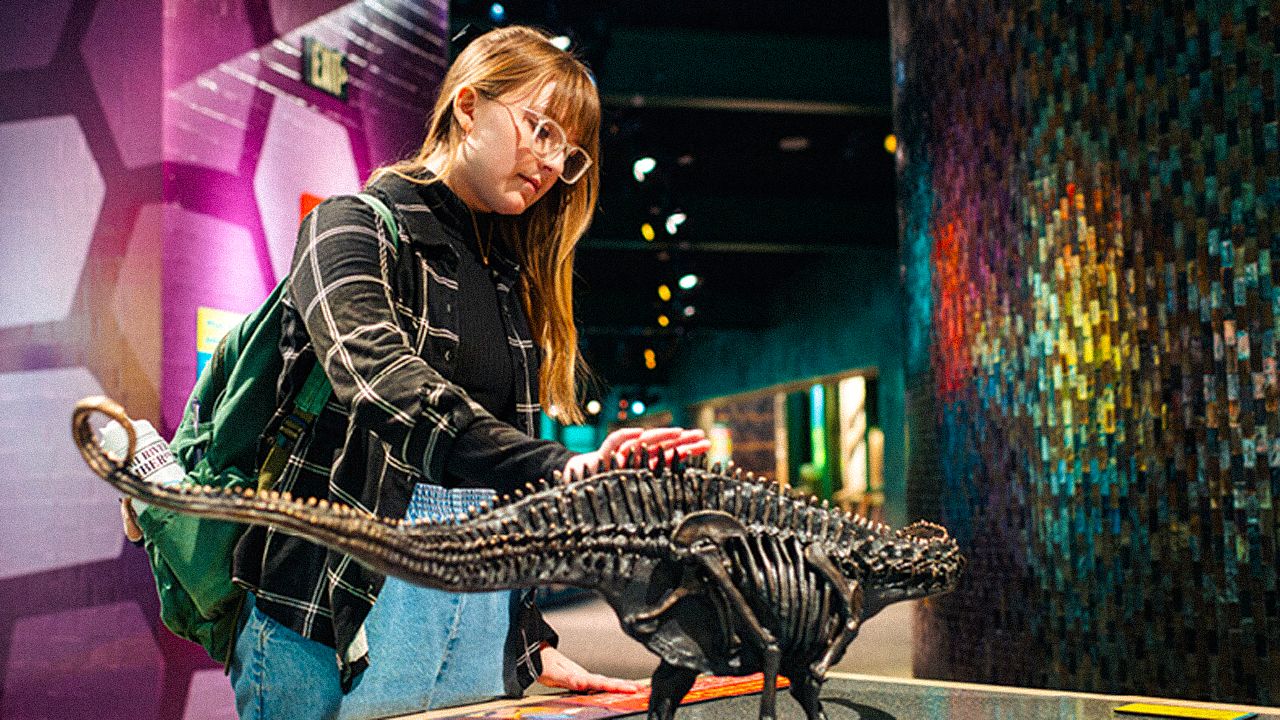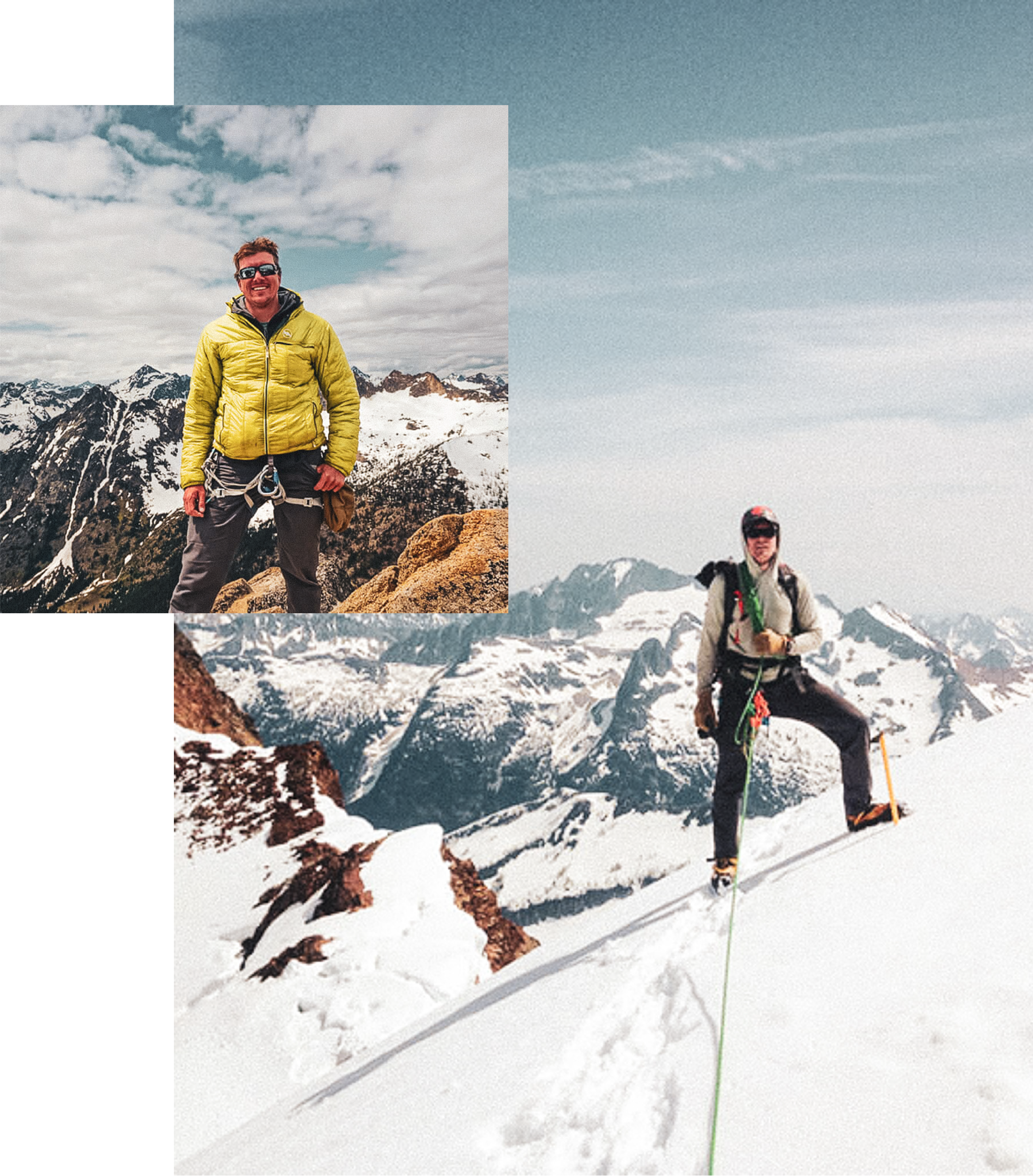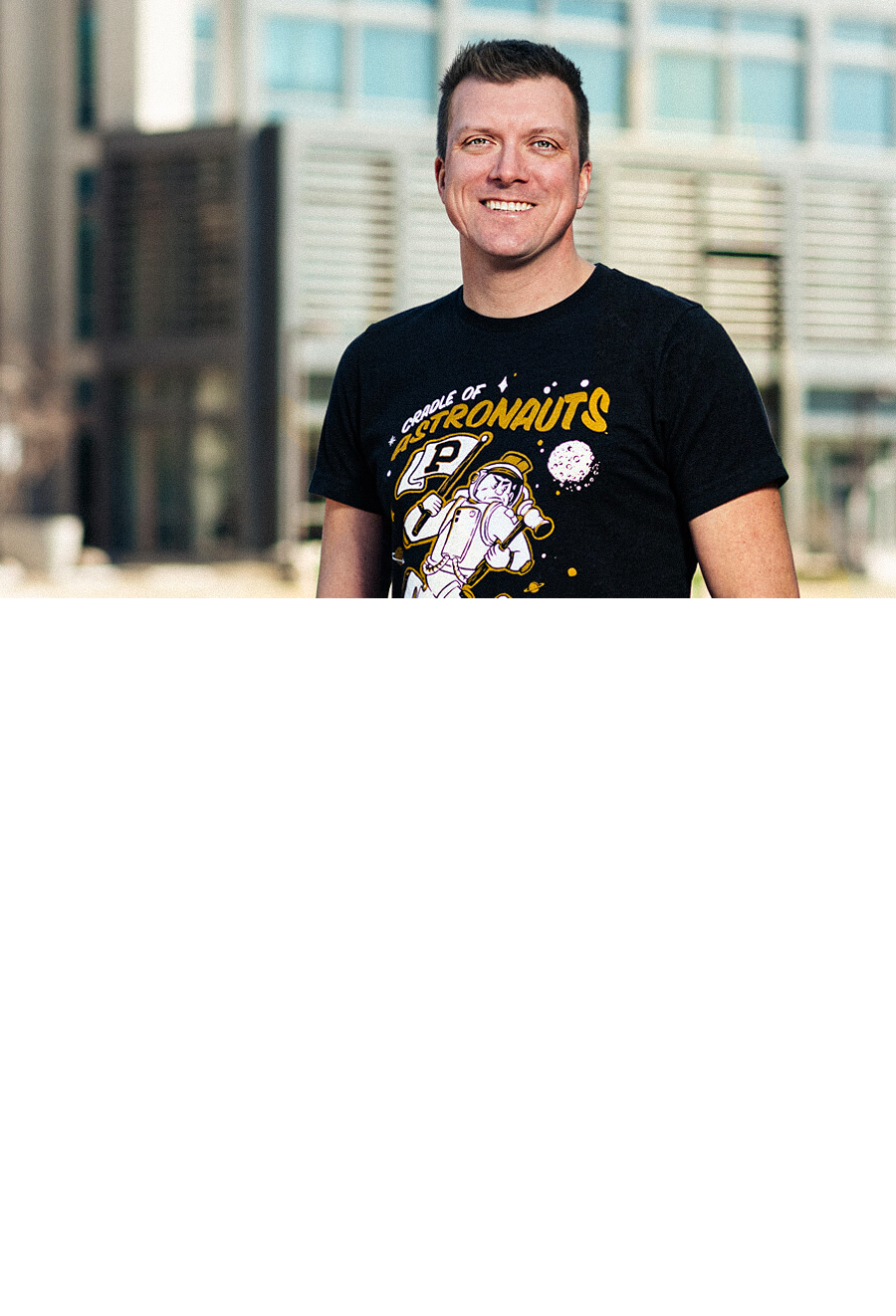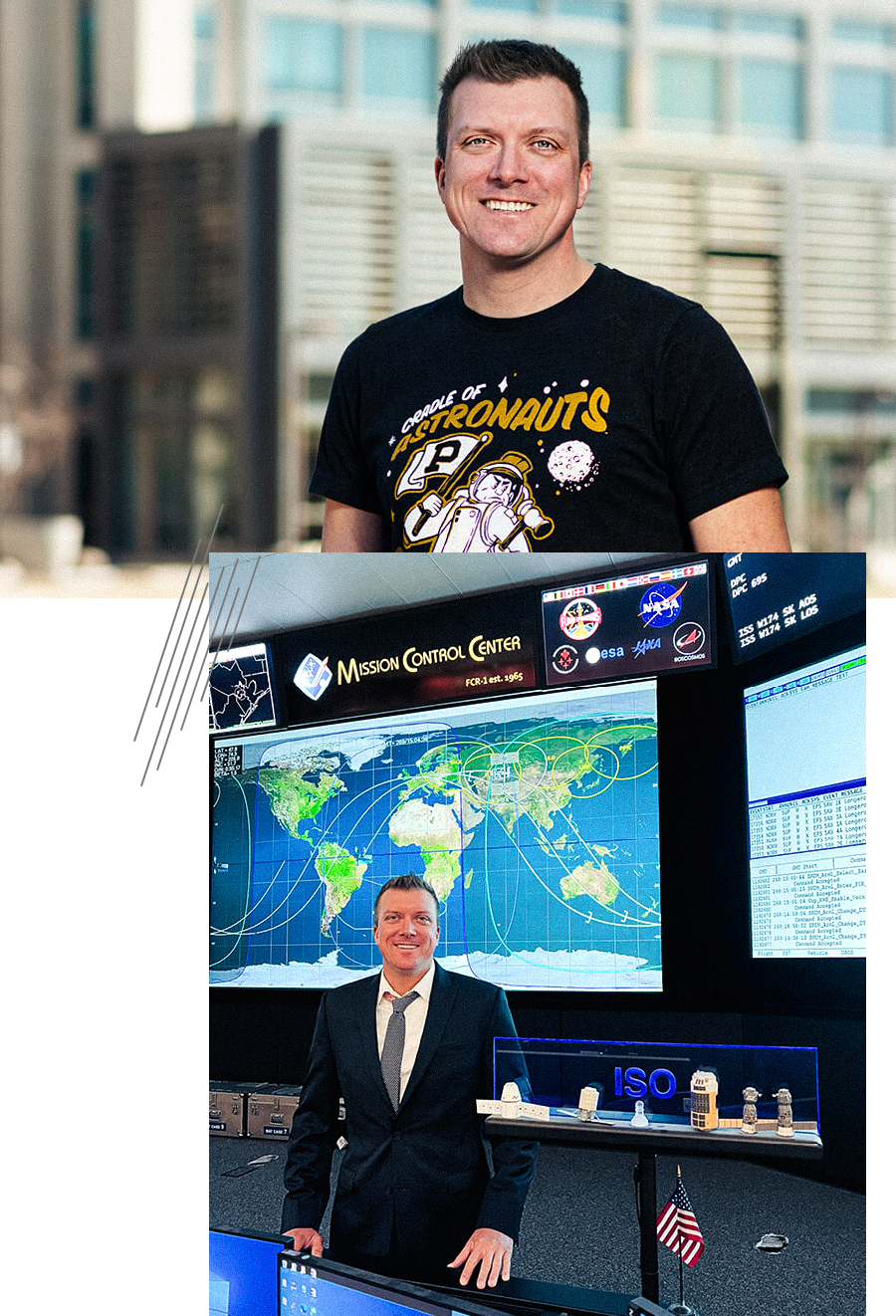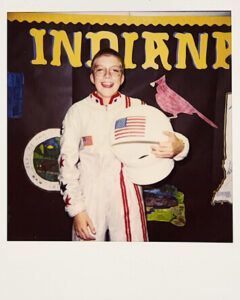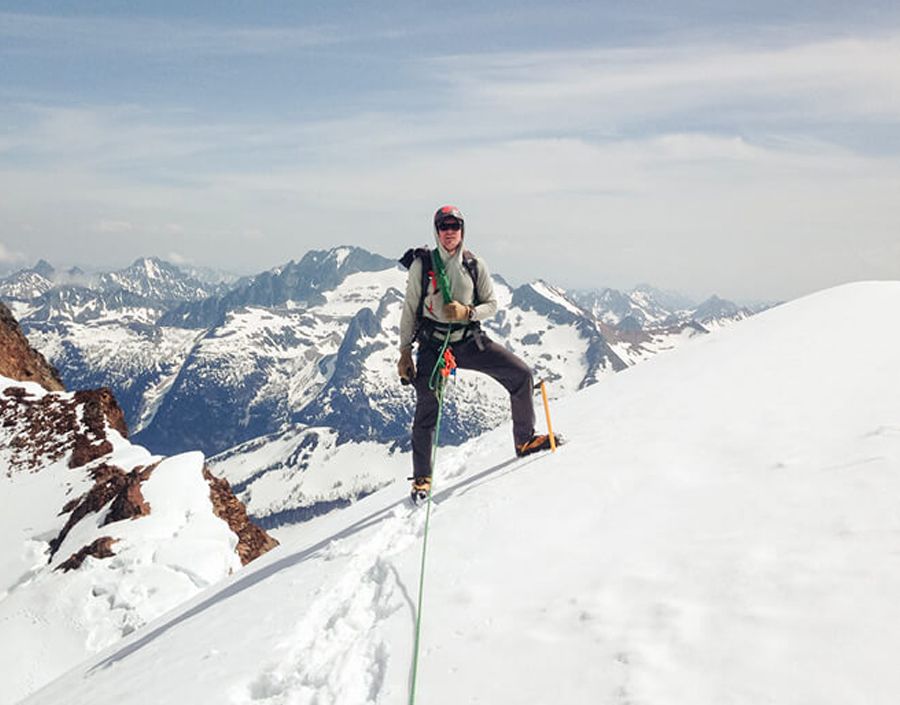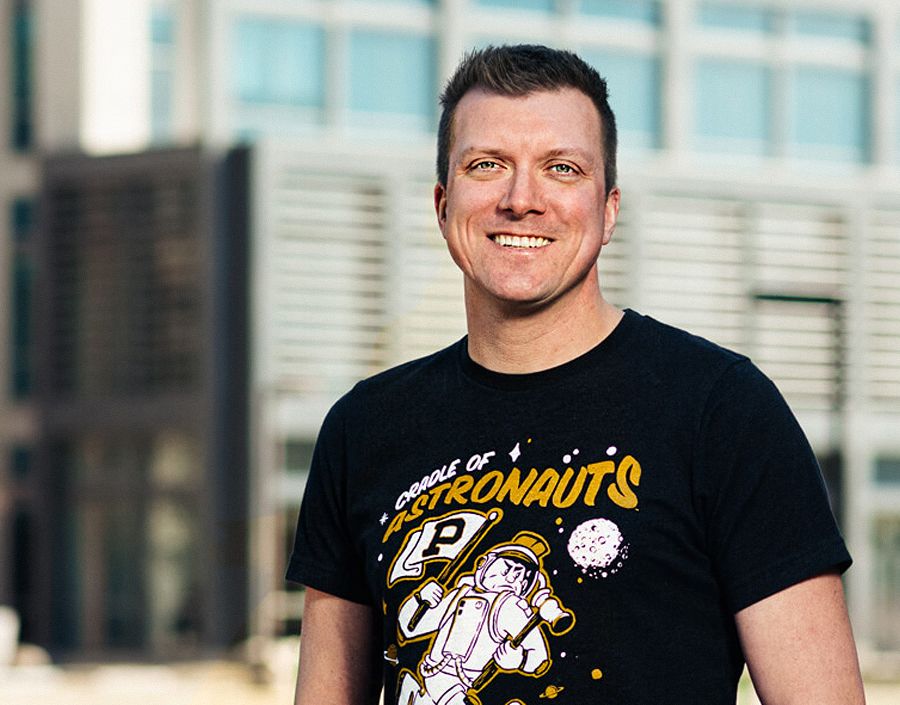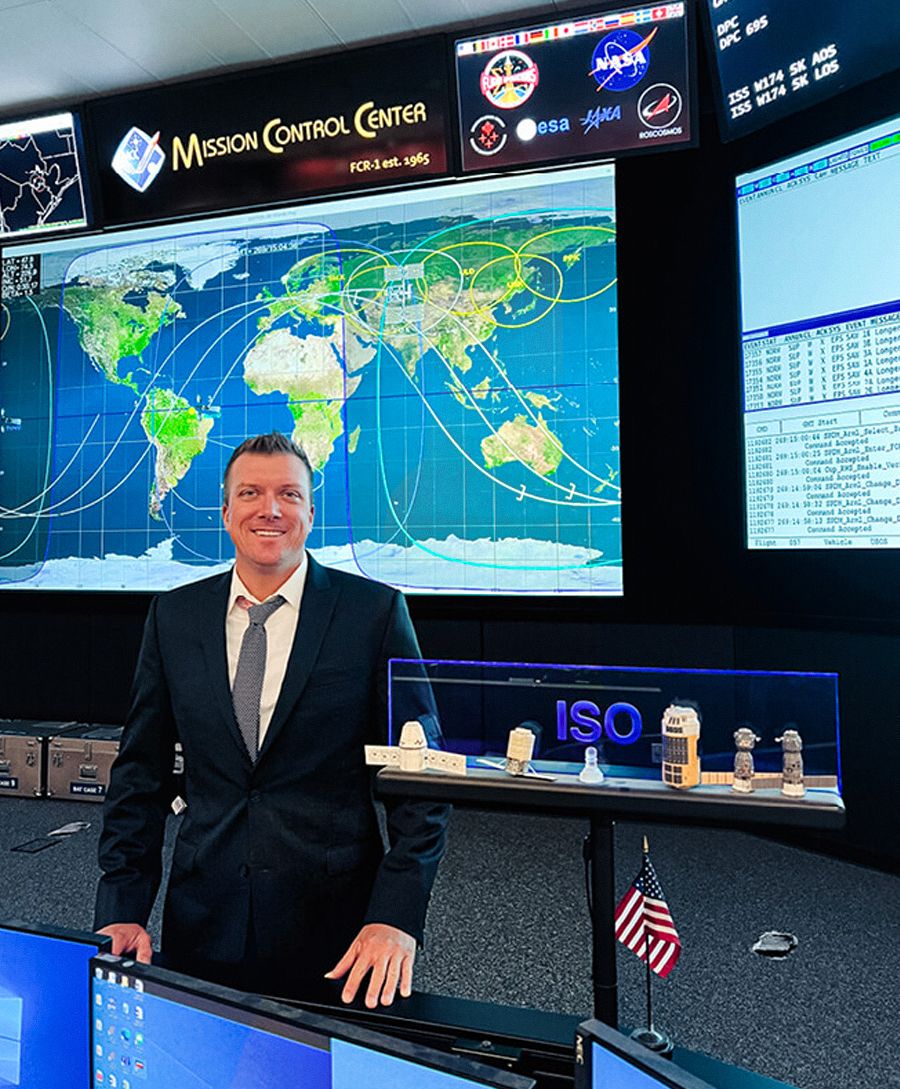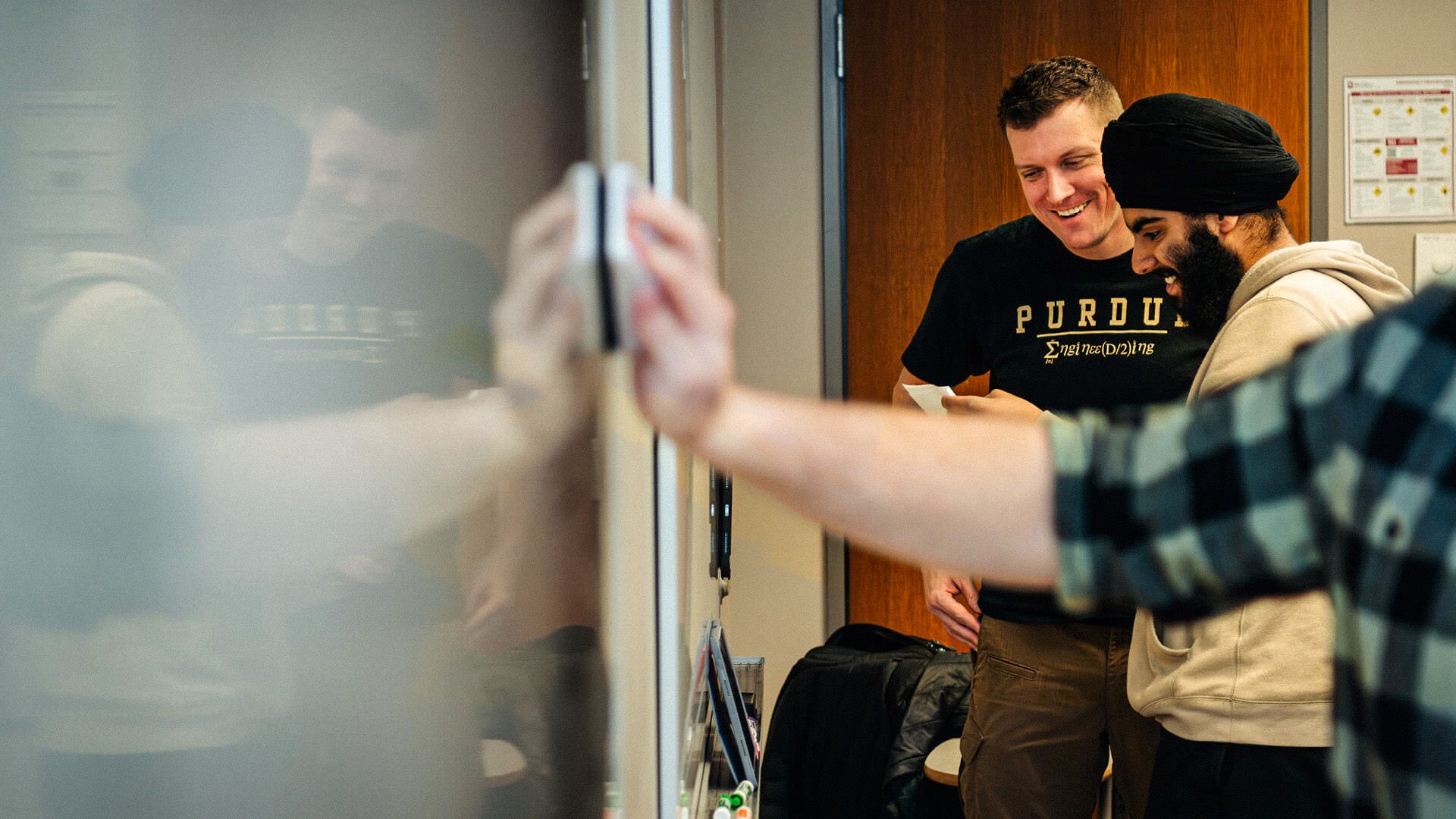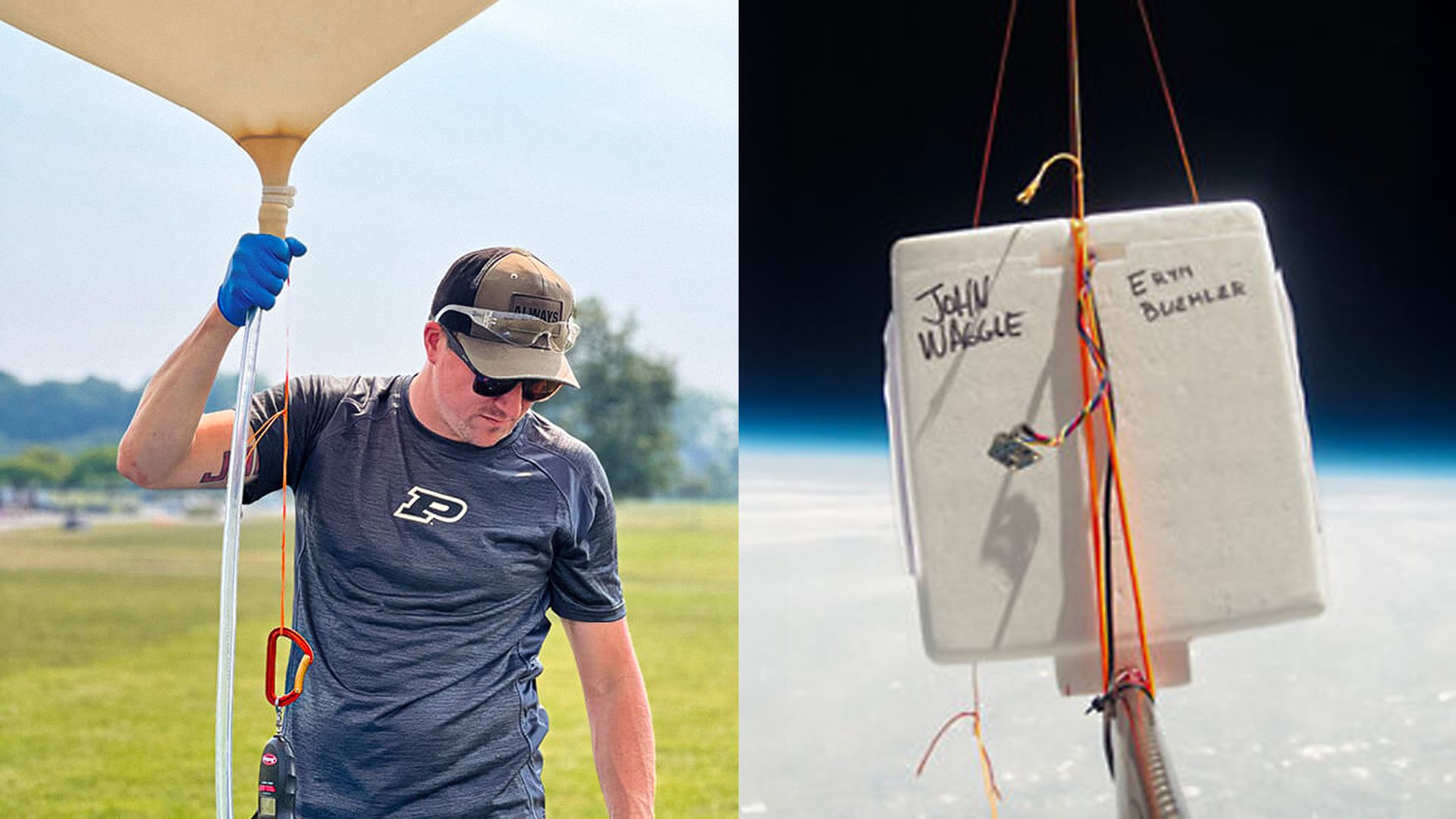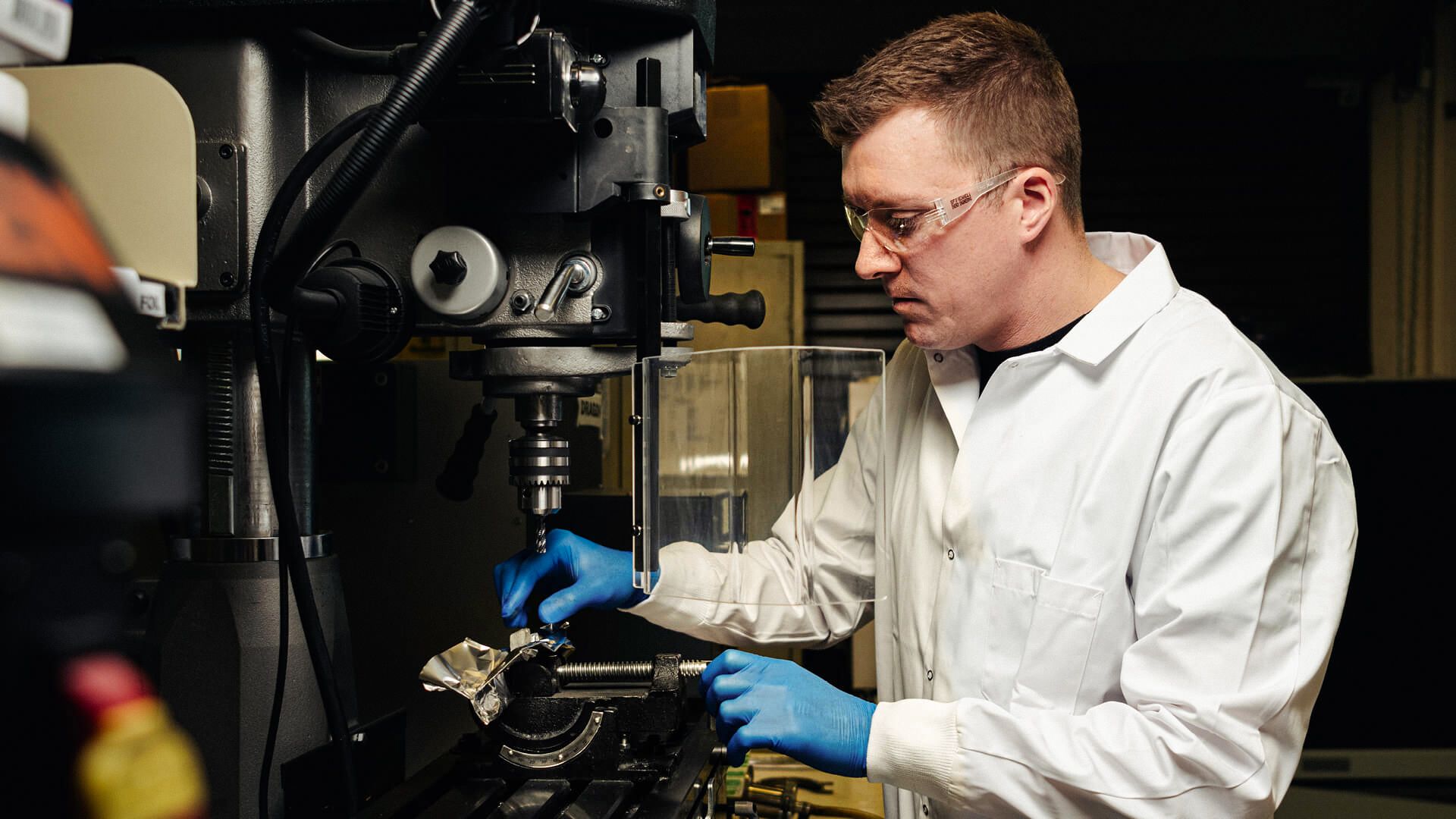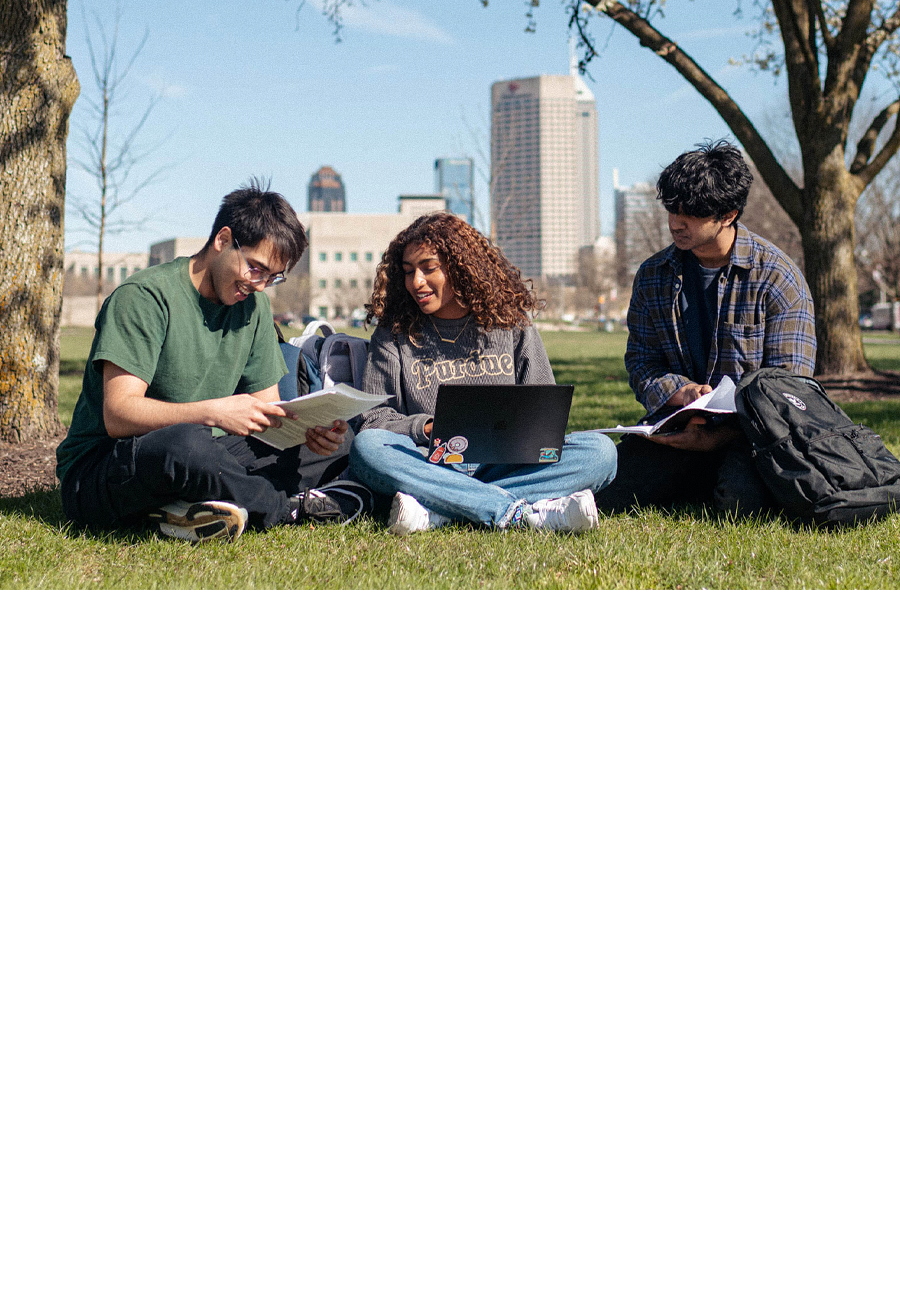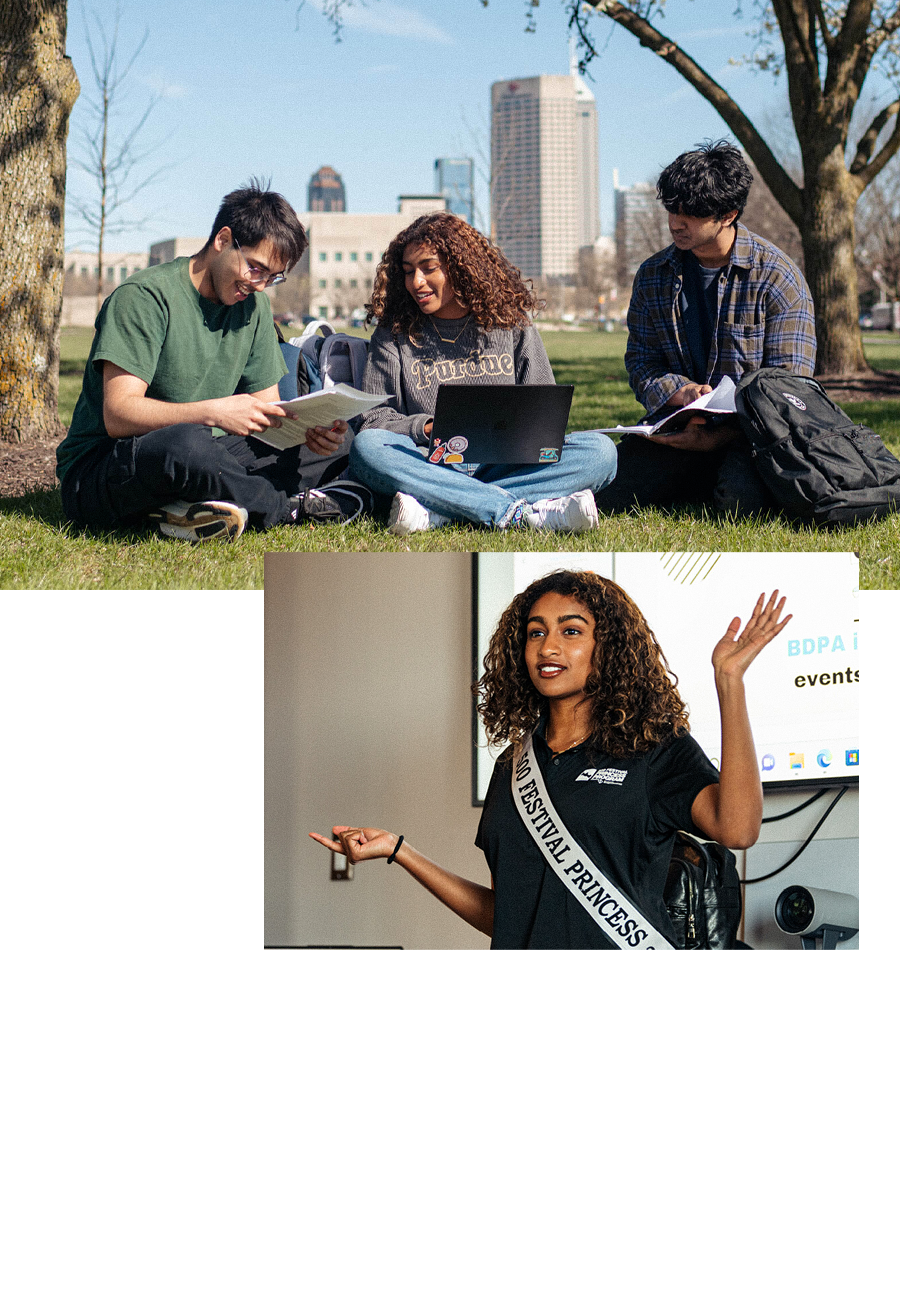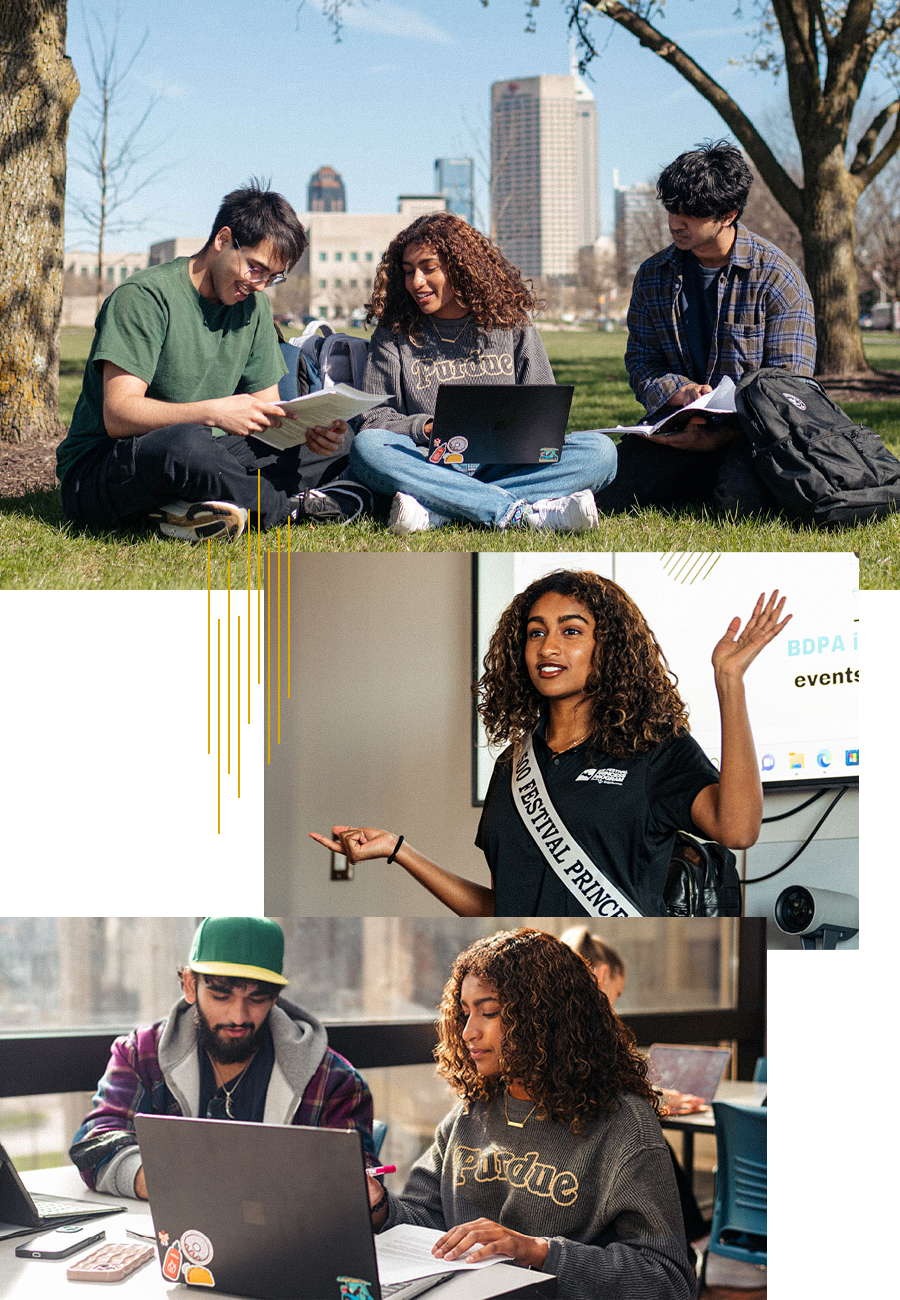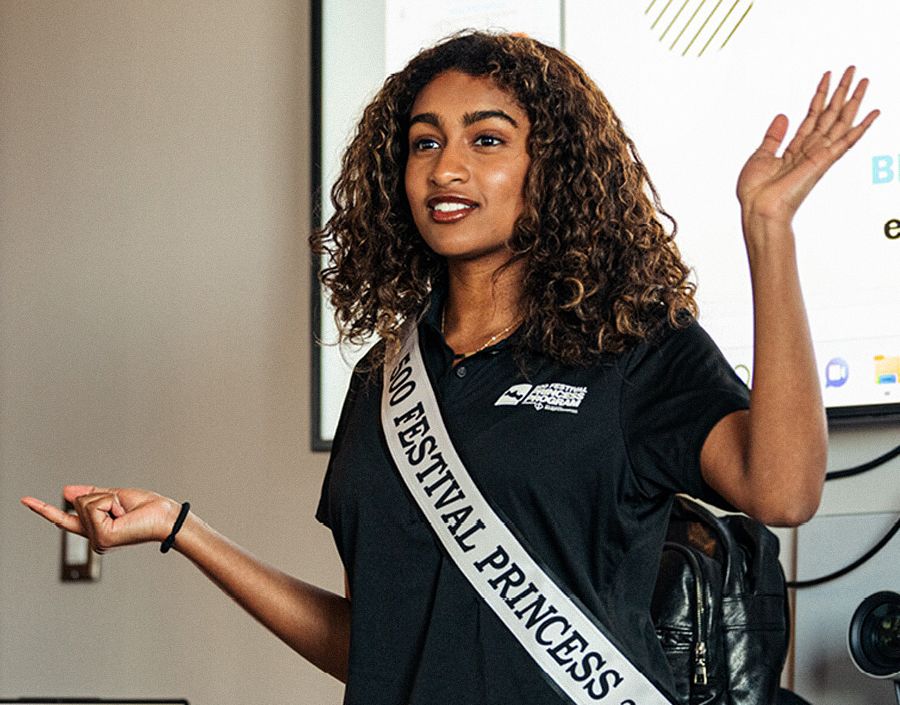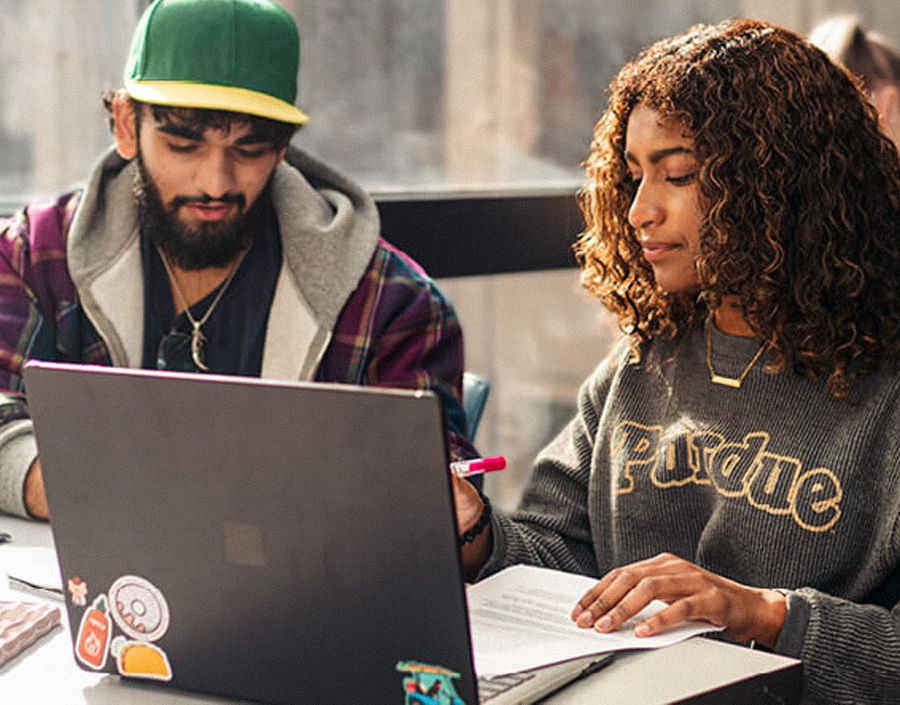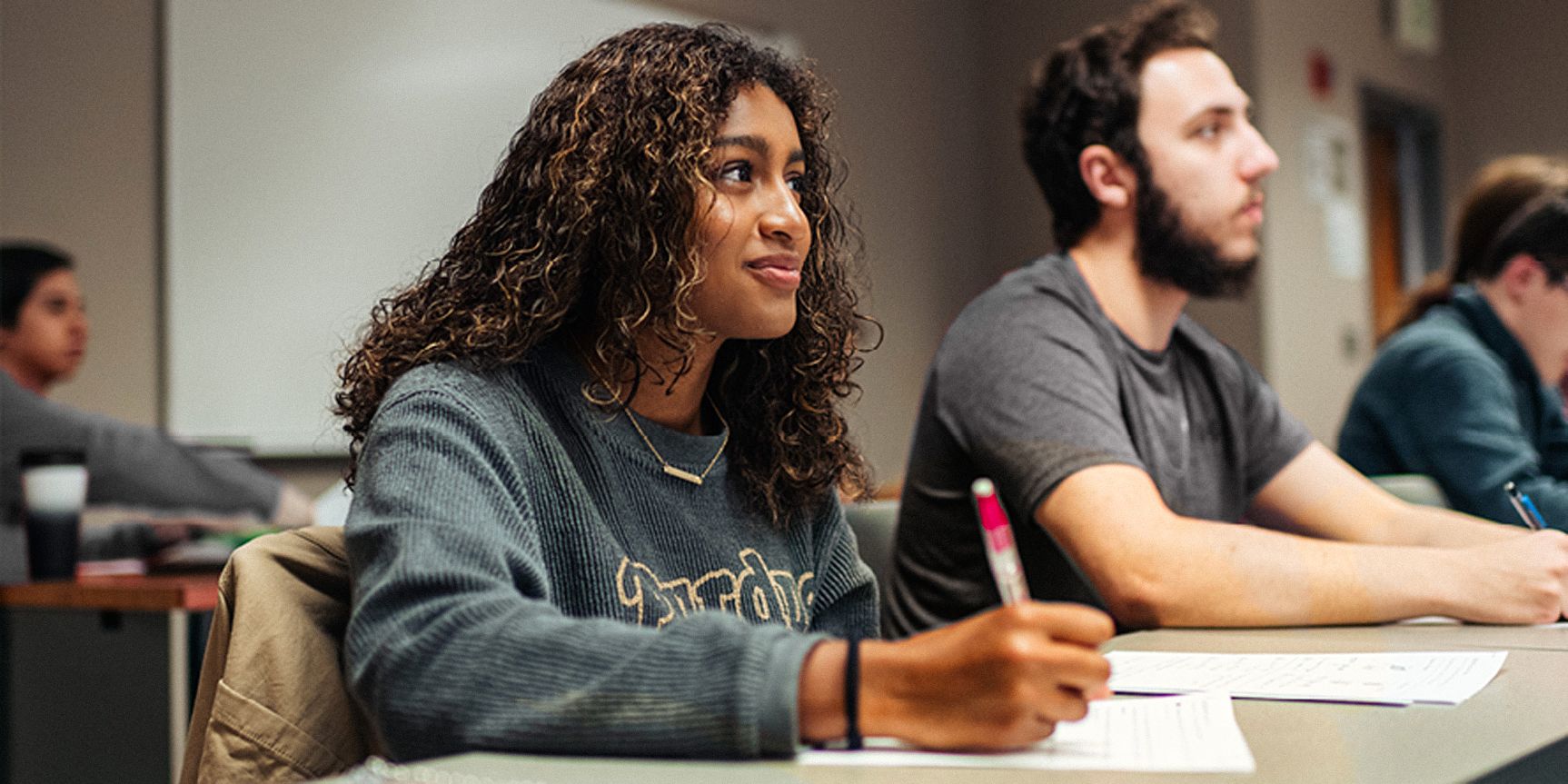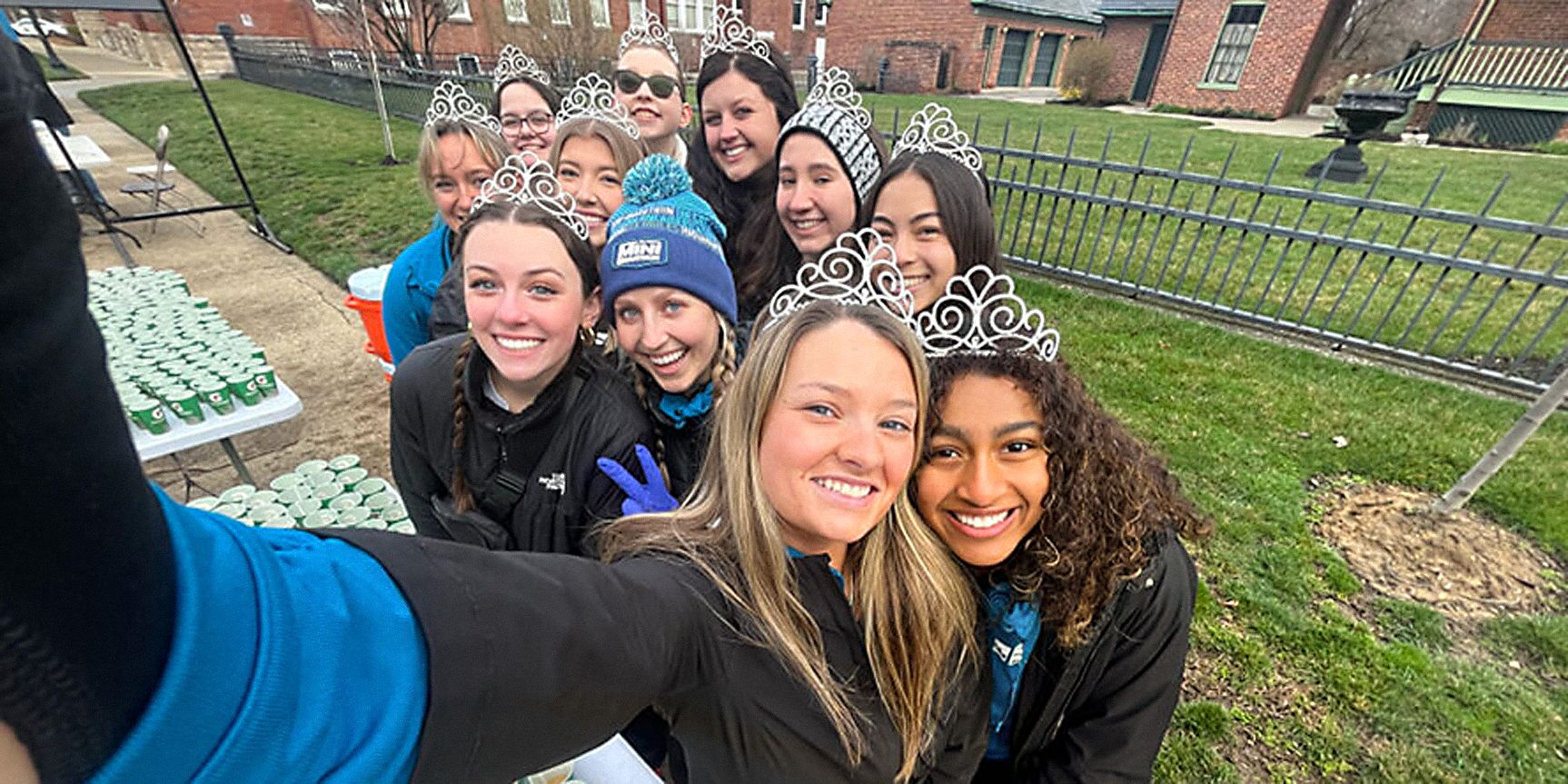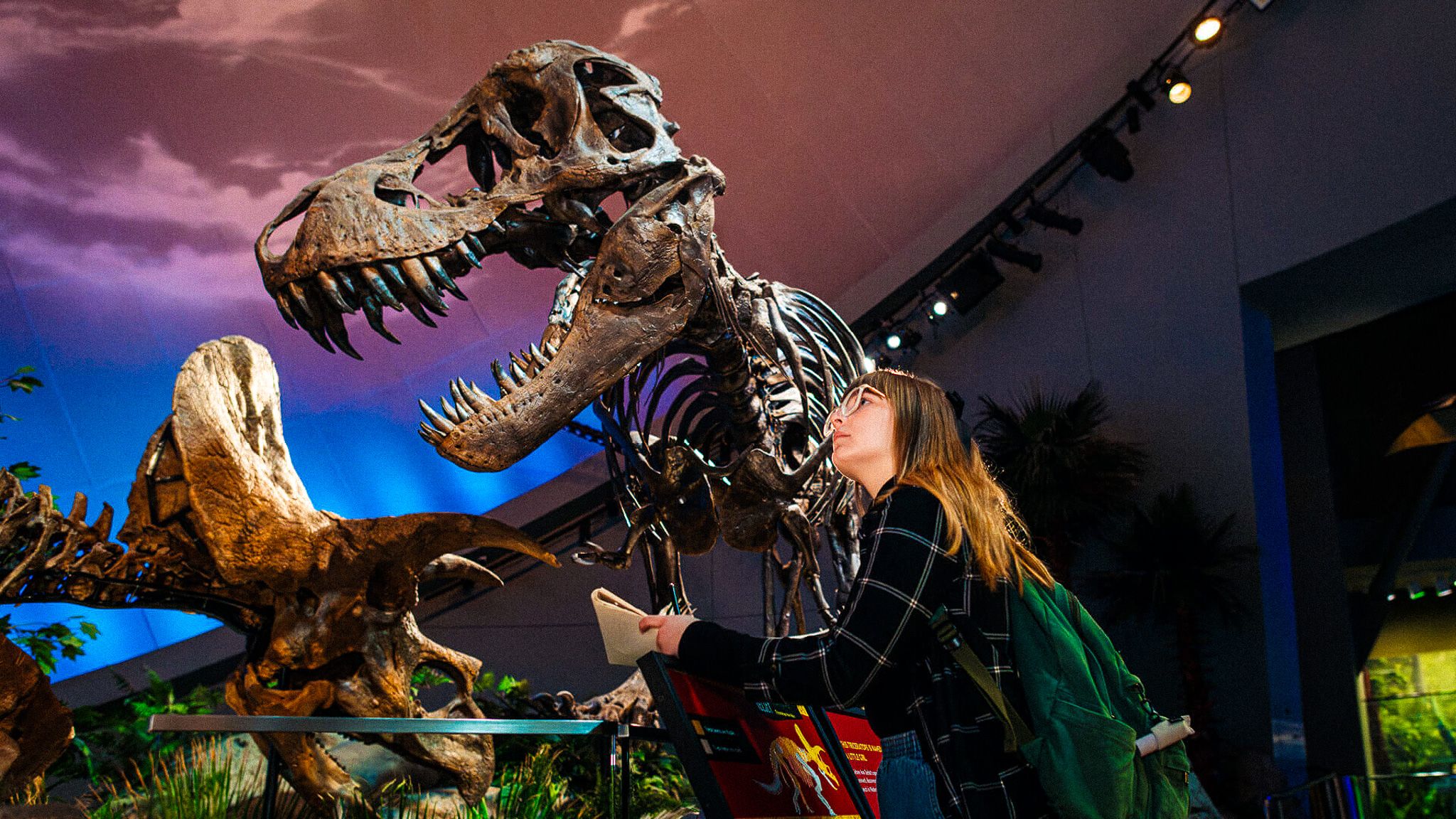
THE NEXT GENERATION OF BOILERMAKERS IS EMERGING AT PURDUE UNIVERSITY IN INDIANAPOLIS, THE UNIVERSITY’S NEW URBAN EXPANSION OF ITS WEST LAFAYETTE CAMPUS.
FORGED IN THE FIELD, THESE STUDENTS ARE DIVING HEADFIRST INTO REAL-WORLD CHALLENGES AND REDEFINING THE EDUCATIONAL LANDSCAPE.

THE THRILL OF IT ALL
INDUSTRY INTERNSHIPS, FLEXIBLE CLASS SCHEDULES, AND SUPPORTIVE PROFESSORS ARE JUST A FEW OF THE THINGS THAT CARYS GEORGE—A STUDENT IN THEMED ENTERTAINMENT DESIGN—LOVES ABOUT HER MAJOR. RIDING ROLLER COASTERS AS PART OF HER EDUCATION?
That’s just a bonus.
Cedar Point in Sandusky, Ohio, opened in the late 1800s and is considered the second-oldest operating amusement park in the U.S. It’s home to 68 rides, including 18 world-class roller coasters. George has ridden them all.
“Last summer, I was a ride audit intern at Cedar Point working in the operations office,” she says. “There were just two auditing interns, so we were pretty busy.”
What exactly is a ride audit? It’s one of Cedar Point’s methods of making sure that rules and safety procedures are being followed. Every park in the Cedar Fair chain, which owns Cedar Point, is certified under a specific operations protocol. It was George’s job to help ensure the system was being followed.
Ride audits happen in two ways: in uniform and undercover.
“When you audit in uniform, it’s very obvious to everyone why you are there. For undercover audits, you dress up as a guest. Sunglasses. Wigs. Outfits. I had a drawer full of props that I would use. Sometimes we even had spy glasses with a camera in them.”
George’s duties in this role varied. Some days she would ride attractions as a guest and make note of any violations. At other times, she used a fake pass—or even no pass—in the fast lane to see how employees would handle it. She also monitored alternate queues and elevators for guests who could not wait in line or needed assistance accessing a ride.
George loved her summer internship at Cedar Point so much that she extended it into late October—something she was able to do while still taking classes full time because of the flexible nature of the themed entertainment design major.
“In August, I realized I wanted to keep working at Cedar Point,” she says. “Because the themed entertainment design program is asynchronous, I was able to do all of my classwork from Ohio while still working 30 to 40 hours a week.”
Asynchronous learning allows students to set their own schedule within a certain time frame. They can access and complete lectures, readings, homework, and other learning materials at the time that works best for them.
The themed entertainment design major brings together multiple disciplines, which is one of George’s favorite things about the program.
“I love the combination of technology with leadership, operations, and creativity. It all comes together in themed entertainment.”
She is attracted to the management side of the industry. Many of her classes feature project management tools like Trello and Monday.com; she also explores the design side, which means using Figma, Maya 3D animation software, Adobe’s creative suite, and SketchUp 3D modeling software.
“We learn about things like taking a building and turning it into a schematic so that we can adjust spaces and change the flow of people,” she says. “We are learning how to be visual and spatial storytellers, and design obviously plays a big role in that.”
George also says that many of her courses involve group work, which has been an easy way to make friends, through both in-person gatherings with students living in Indianapolis and online meetups with those who are taking classes from farther away.
George sometimes refers to her major as “edutainment” because it combines education with real-world entertainment experience. Case studies and hands-on learning that supplement class materials are a key aspect of the program.
This past semester, George was able to conduct case studies in partnership with the Children’s Museum of Indianapolis. She took photos and videos and jotted down notes from a guest perspective to explore the storytelling and design techniques being used.
“My professors say that you can’t create exhibits without first experiencing them yourself.”
As a themed entertainment design major, George has found living in Indianapolis helpful. Not only does the city have a variety of museums and performance venues, it also regularly hosts national exhibits and conventions.
“Experiences flood in and out of Indy,” she says. “And my friends and I love going to as many as we can.”
Whether it’s LEGO Brickworld or Jurassic Quest, there is always something to see and do. George says that being in the city has been a huge part of her experience as a student. She loves being able to encounter so many things, but the city itself factors in her learning.
“I love having everything accessible,” she says. “And I feel so inspired by Indianapolis.”
And when she graduates?
“I think I will probably return to Cedar Point,” she says. “I know they need people like me, especially in the office, and I love that work.”
Read more about George’s experiences at Purdue University in Indianapolis.
THE THRILL OF IT ALL
INDUSTRY INTERNSHIPS, FLEXIBLE CLASS SCHEDULES, AND SUPPORTIVE PROFESSORS ARE JUST A FEW OF THE THINGS THAT CARYS GEORGE—A STUDENT IN THEMED ENTERTAINMENT DESIGN—LOVES ABOUT HER MAJOR. RIDING ROLLER COASTERS AS PART OF HER EDUCATION?
That’s just a bonus.
Cedar Point in Sandusky, Ohio, opened in the late 1800s and is considered the second-oldest operating amusement park in the U.S. It’s home to 68 rides, including 18 world-class roller coasters. George has ridden them all.
“Last summer, I was a ride audit intern at Cedar Point working in the operations office,” she says. “There were just two auditing interns, so we were pretty busy.”
What exactly is a ride audit? It’s one of Cedar Point’s methods of making sure that rules and safety procedures are being followed. Every park in the Cedar Fair chain, which owns Cedar Point, is certified under a specific operations protocol. It was George’s job to help ensure the system was being followed.
Ride audits happen in two ways: in uniform and undercover.
“When you audit in uniform, it’s very obvious to everyone why you are there. For undercover audits, you dress up as a guest. Sunglasses. Wigs. Outfits. I had a drawer full of props that I would use. Sometimes we even had spy glasses with a camera in them.”
George’s duties in this role varied. Some days she would ride attractions as a guest and make note of any violations. At other times, she used a fake pass—or even no pass—in the fast lane to see how employees would handle it. She also monitored alternate queues and elevators for guests who could not wait in line or needed assistance accessing a ride.
George loved her summer internship at Cedar Point so much that she extended it into late October—something she was able to do while still taking classes full time because of the flexible nature of the themed entertainment design major.
“In August, I realized I wanted to keep working at Cedar Point,” she says. “Because the themed entertainment design program is asynchronous, I was able to do all of my classwork from Ohio while still working 30 to 40 hours a week.”
Asynchronous learning allows students to set their own schedule within a certain time frame. They can access and complete lectures, readings, homework, and other learning materials at the time that works best for them.
The themed entertainment design major brings together multiple disciplines, which is one of George’s favorite things about the program.
“I love the combination of technology with leadership, operations, and creativity. It all comes together in themed entertainment.”
She is attracted to the management side of the industry. Many of her classes feature project management tools like Trello and Monday.com; she also explores the design side, which means using Figma, Maya 3D animation software, Adobe’s creative suite, and SketchUp 3D modeling software.
“We learn about things like taking a building and turning it into a schematic so that we can adjust spaces and change the flow of people,” she says. “We are learning how to be visual and spatial storytellers, and design obviously plays a big role in that.”
George also says that many of her courses involve group work, which has been an easy way to make friends, through both in-person gatherings with students living in Indianapolis and online meetups with those who are taking classes from farther away.
George sometimes refers to her major as “edutainment” because it combines education with real-world entertainment experience. Case studies and hands-on learning that supplement class materials are a key aspect of the program.
This past semester, George was able to conduct case studies in partnership with the Children’s Museum of Indianapolis. She took photos and videos and jotted down notes from a guest perspective to explore the storytelling and design techniques being used.
“My professors say that you can’t create exhibits without first experiencing them yourself.”
As a themed entertainment design major, George has found living in Indianapolis helpful. Not only does the city have a variety of museums and performance venues, it also regularly hosts national exhibits and conventions.
“Experiences flood in and out of Indy,” she says. “And my friends and I love going to as many as we can.”
Whether it’s LEGO Brickworld or Jurassic Quest, there is always something to see and do. George says that being in the city has been a huge part of her experience as a student. She loves being able to encounter so many things, but the city itself factors in her learning.
“I love having everything accessible,” she says. “And I feel so inspired by Indianapolis.”
And when she graduates?
“I think I will probably return to Cedar Point,” she says. “I know they need people like me, especially in the office, and I love that work.”
Read more about George’s experiences at Purdue University in Indianapolis.
“MY PROFESSORS SAY THAT YOU CAN’T CREATE EXHIBITS WITHOUT FIRST EXPERIENCING THEM YOURSELF.”
George is learning how to create exhibits, like this one at the Children’s Museum in Indianapolis, by experiencing them for herself.
George is learning how to create exhibits, like this one at the Children’s Museum in Indianapolis, by experiencing them for herself.
George says that her professors’ innovative approaches to learning have contributed to her success outside of the classroom.
George says that her professors’ innovative approaches to learning have contributed to her success outside of the classroom.
Hands-on learning at venues such as the Children’s Museum in Indianapolis supplement the concepts George is learning in her classes.
Hands-on learning at venues such as the Children’s Museum in Indianapolis supplement the concepts George is learning in her classes.
George is learning how to create exhibits, like this one at the Children’s Museum in Indianapolis, by experiencing them for herself.
George is learning how to create exhibits, like this one at the Children’s Museum in Indianapolis, by experiencing them for herself.
George says that her professors’ innovative approaches to learning have contributed to her success outside of the classroom.
George says that her professors’ innovative approaches to learning have contributed to her success outside of the classroom.
Hands-on learning at venues such as the Children’s Museum in Indianapolis supplement the concepts George is learning in her classes.
Hands-on learning at venues such as the Children’s Museum in Indianapolis supplement the concepts George is learning in her classes.
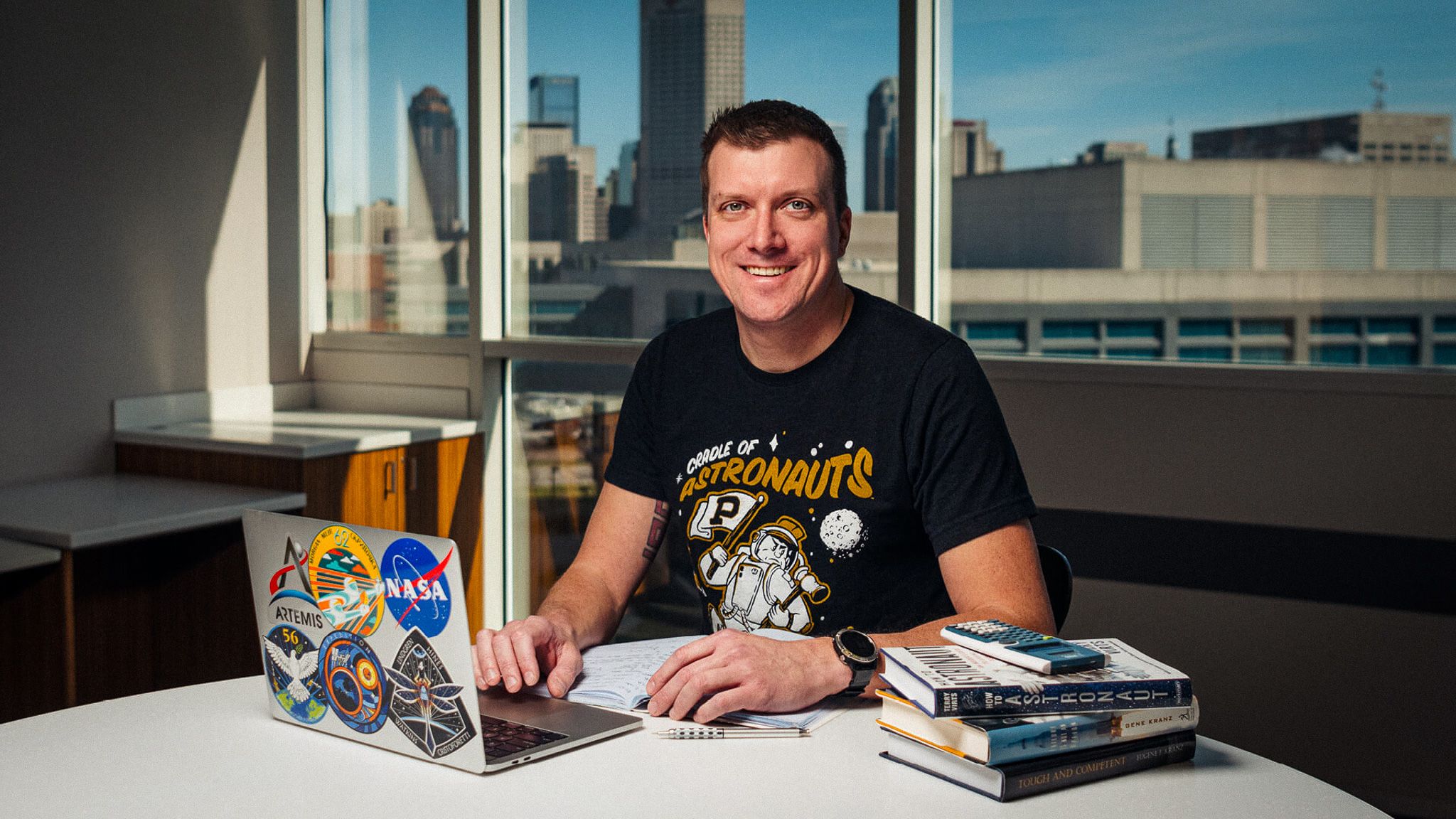
NO HOLDING BACK
JOHN WAGGLE’S JOURNEY TO PURDUE UNIVERSITY IN INDIANAPOLIS STARTED WITH A FATEFUL COSTUME SELECTION IN ELEMENTARY SCHOOL.
“In fourth grade, we had a dress-up day celebrating famous Indiana residents. I immediately chose Gus Grissom (ME’50) because I always wanted to be a Boilermaker, and I always wanted to be an astronaut.”
Waggle still aspires to have a career in space. And he hopes to become the first Purdue student in Indianapolis to join the Cradle of Astronauts.
Indiana University-Purdue University Indianapolis was Waggle’s college of choice when he graduated from high school. Growing up on Indy’s east side, he was familiar with both the campus and the school’s well-regarded mechanical engineering technology program.
“It was a solid decision for me at the time,” Waggle says. “But after a few years, I felt a strong pull toward the military. And I knew if I was going to achieve that dream, I needed to pursue it while I was still young.”
Waggle paused his IUPUI education to join the Navy, where he put his academic aptitude and experience into action. He traveled the world for 10 years as a nuclear mechanic, including three years on a submarine and five years on an aircraft carrier.
As Waggle’s second tour of duty ended, he began thinking through his next steps. A cross-country and distance runner in high school, he had always been drawn to activities that pushed his physical limits. And after the high-stress confined environments of a submarine and an aircraft carrier, Waggle craved wide-open spaces.
He decided to use his GI Bill benefits to enroll in the American Alpine Institute.
Rock climbing, backcountry skiing, ice climbing, and “dangling off the side of a mountain” were all part of Waggle’s preparation for becoming a mountain guide. But a climbing accident sent him in a new direction.
“Seeing life and death on the mountain—understanding how small we are, how impermanent life is—made me reflect deeply on my future.”
Waggle’s next giant leap took him from the mountains of the Pacific Northwest to the summit of Maunakea—a dormant volcano, the highest point in Hawaii, and home to the W.M. Keck Observatory. There, he worked as a support supervisor for the team of technicians who change over the twin Keck Observatory telescopes from night to daytime operations.
And then COVID hit.
“It made me realize that I had been away from family for too many years,” he says. “And the decision to return home to Indianapolis felt automatic.”
COVID also prompted Waggle to consider his next career steps.
“There were times when I found myself in professional situations not being taken seriously because I didn’t have a college degree,” he says. “And so I decided to use the GI Bill to return to IUPUI and finish my mechanical engineering technology degree.”
Waggle moved back to Indianapolis just as spring COVID closures started to hit. “I had hours and hours of time that I needed to fill,” he says. “So I just started doing math homework.”
Seven hours a day, seven days a week, Waggle worked his way through every math textbook and online problem set he could get his hands on. His efforts paid off when he enrolled in the summer semester. Waggle hit the ground running with a blistering 18-credit course load, including two math classes.
“I was performing at a level that I didn’t even think myself capable of,” he says. “I got a 100% on a math test, and a light bulb just went off. I realized that if I put everything I had into my education, I could push myself further than I ever thought possible.”
This realization prompted Waggle to take another giant leap. He switched his major from mechanical engineering technology to mechanical engineering.
“Everybody looked at me funny,” he says. “Most people switch ME majors in the other direction, so I was swimming upstream with this decision.”
“I knew it would be difficult and maybe even uncomfortable at times, but I knew that I could do it. I would rather fall short attempting something really difficult than not try at all.”
With this new mindset, Waggle allowed himself to revisit his childhood dream of becoming an astronaut—to set a goal for himself of making that dream a reality.
Waggle learned of the highly competitive NASA Pathways program at a lecture he attended on the space agency’s all-electric experimental Maxwell aircraft. The presenters encouraged him to apply, and he went for it. Waggle ultimately ended up at Johnson Space Center, where he worked in the Flight Operations Directorate on the Automated Stowage Drawings project.
Waggle’s first internship with NASA ended in December, he completed another internship over the summer, and he has a third lined up for the fall.
Waggle transitioned from IUPUI to Purdue University in Indianapolis when the school officially launched July 1. He is excited about the new opportunities this will create, especially for collaboration between Purdue’s two campuses.
“I look forward to making connections with the West Lafayette campus and its students,” he says. “My life is centered in Indianapolis, and it makes sense for me to live and learn here. But I am excited to have back-and-forth exchanges and increased involvement between the two campuses.”
Read more about Waggle’s experiences at Purdue University in Indianapolis.
NO HOLDING BACK
JOHN WAGGLE’S JOURNEY TO PURDUE UNIVERSITY IN INDIANAPOLIS STARTED WITH A FATEFUL COSTUME SELECTION IN ELEMENTARY SCHOOL.
“In fourth grade, we had a dress-up day celebrating famous Indiana residents. I immediately chose Gus Grissom (ME’50) because I always wanted to be a Boilermaker, and I always wanted to be an astronaut.”
Waggle still aspires to have a career in space. And he hopes to become the first Purdue student in Indianapolis to join the Cradle of Astronauts.
Indiana University-Purdue University Indianapolis was Waggle’s college of choice when he graduated from high school. Growing up on Indy’s east side, he was familiar with both the campus and the school’s well-regarded mechanical engineering technology program.
“It was a solid decision for me at the time,” Waggle says. “But after a few years, I felt a strong pull toward the military. And I knew if I was going to achieve that dream, I needed to pursue it while I was still young.”
Waggle paused his IUPUI education to join the Navy, where he put his academic aptitude and experience into action. He traveled the world for 10 years as a nuclear mechanic, including three years on a submarine and five years on an aircraft carrier.
As Waggle’s second tour of duty ended, he began thinking through his next steps. A cross-country and distance runner in high school, he had always been drawn to activities that pushed his physical limits. And after the high-stress confined environments of a submarine and an aircraft carrier, Waggle craved wide-open spaces.
He decided to use his GI Bill benefits to enroll in the American Alpine Institute.
Rock climbing, backcountry skiing, ice climbing, and “dangling off the side of a mountain” were all part of Waggle’s preparation for becoming a mountain guide. But a climbing accident sent him in a new direction.
“Seeing life and death on the mountain—understanding how small we are, how impermanent life is—made me reflect deeply on my future.”
Waggle’s next giant leap took him from the mountains of the Pacific Northwest to the summit of Maunakea—a dormant volcano, the highest point in Hawaii, and home to the W.M. Keck Observatory. There, he worked as a support supervisor for the team of technicians who change over the twin Keck Observatory telescopes from night to daytime operations.
And then COVID hit.
“It made me realize that I had been away from family for too many years,” he says. “And the decision to return home to Indianapolis felt automatic.”
COVID also prompted Waggle to consider his next career steps.
“There were times when I found myself in professional situations not being taken seriously because I didn’t have a college degree,” he says. “And so I decided to use the GI Bill to return to IUPUI and finish my mechanical engineering technology degree.”
Waggle moved back to Indianapolis just as spring COVID closures started to hit. “I had hours and hours of time that I needed to fill,” he says. “So I just started doing math homework.”
Seven hours a day, seven days a week, Waggle worked his way through every math textbook and online problem set he could get his hands on. His efforts paid off when he enrolled in the summer semester. Waggle hit the ground running with a blistering 18-credit course load, including two math classes.
“I was performing at a level that I didn’t even think myself capable of. I got a 100% on a math test, and a light bulb just went off. I realized that if I put everything I had into my education, I could push myself further than I ever thought possible.”
This realization prompted Waggle to take another giant leap. He switched his major from mechanical engineering technology to mechanical engineering.
“Everybody looked at me funny,” he says. “Most people switch ME majors in the other direction, so I was swimming upstream with this decision. I knew it would be difficult and maybe even uncomfortable at times, but I knew that I could do it. I would rather fall short attempting something really difficult than not try at all.”
With this new mindset, Waggle allowed himself to revisit his childhood dream of becoming an astronaut—to set a goal for himself of making that dream a reality.
Waggle learned of the highly competitive NASA Pathways program at a lecture he attended on the space agency’s all-electric experimental Maxwell aircraft. The presenters encouraged him to apply, and he went for it. Waggle ultimately ended up at Johnson Space Center, where he worked in the Flight Operations Directorate on the Automated Stowage Drawings project.
Waggle’s first internship with NASA ended in December, he completed another internship over the summer, and he has a third lined up for the fall.
Waggle transitioned from IUPUI to Purdue University in Indianapolis when the school officially launched July 1. He is excited about the new opportunities this will create, especially for collaboration between Purdue’s two campuses.
“I look forward to making connections with the West Lafayette campus and its students,” he says. “My life is centered in Indianapolis, and it makes sense for me to live and learn here. But I am excited to have back-and-forth exchanges and increased involvement between the two campuses.”
Read more about Waggle’s experiences at Purdue University in Indianapolis.
“I ALWAYS WANTED TO BE A BOILERMAKER, AND I ALWAYS WANTED TO BE AN ASTRONAUT.”
John Waggle collaborating with a Purdue student in Indianapolis.
John Waggle collaborating with a Purdue student in Indianapolis.
On campus, Waggle participated in the Students for the Exploration and Development of Space (SEDS) club, helping to engineer and launch weather balloons that measure payload as well as radiation at high altitudes.
On campus, Waggle participated in the Students for the Exploration and Development of Space (SEDS) club, helping to engineer and launch weather balloons that measure payload as well as radiation at high altitudes.
Waggle drilling a sample of MXene nanomaterial in the Anasori Layered Materials and Structures Lab at Purdue in Indianapolis.
Waggle drilling a sample of MXene nanomaterial in the Anasori Layered Materials and Structures Lab at Purdue in Indianapolis.
John Waggle collaborating with a Purdue student in Indianapolis.
John Waggle collaborating with a Purdue student in Indianapolis.
On campus, Waggle participated in the Students for the Exploration and Development of Space (SEDS) club, helping to engineer and launch weather balloons that measure payload as well as radiation at high altitudes.
On campus, Waggle participated in the Students for the Exploration and Development of Space (SEDS) club, helping to engineer and launch weather balloons that measure payload as well as radiation at high altitudes.
Waggle drilling a sample of MXene nanomaterial in the Anasori Layered Materials and Structures Lab at Purdue in Indianapolis.
Waggle drilling a sample of MXene nanomaterial in the Anasori Layered Materials and Structures Lab at Purdue in Indianapolis.

OFF TO THE RACES
WHEN YOUR SCHEDULE IS AS PACKED AS SARAH PAPABATHINI’S, ONLY A PINK WEEKLY PLANNER CAN CONTAIN IT. “MY PLANNER IS THE HOLY GRAIL,” SHE SAYS. “I CARRY IT WITH ME EVERYWHERE AND AM CONSTANTLY REFERRING TO IT. ALWAYS ASKING MYSELF, ‘OK, WHAT’S NEXT?’”
It turns out that “what’s next” is quite a lot.
Papabathini, who is studying AI, takes advantage of all the city and university have to offer, whether it’s community engagement, academic research, or just fun with friends.
Growing up in Chicago, Papabathini learned firsthand the value of meaningful after-school activities.
“My dad worked late when I was younger, so I was enrolled in after-school programs,” she says. “I really appreciate what they did for me and am especially grateful for the people who helped run them.”
It was a given for Papabathini that she would pay that gratitude forward by becoming involved in her college community. “I’m a mentor within high schools and middle schools here in the Indianapolis area,” she says.
“I stay in regular contact with my students—meeting with them in person, sending them texts, asking about their days. I especially like to check in when I know they have a test or a big assignment.”
Papabathini started volunteering with DREAM Alive—a youth mentorship program founded by former Indianapolis Colts offensive tackle Tarik Glenn and his wife, Maya—during her first year at Purdue in Indianapolis. DREAM Alive is incredibly successful; it has a 100% high school graduation rate for participants.
Mentors eat a meal with students and then lead a lesson about career and educational opportunities or topics such as mental health and how to identify a trusted adult. “We’re trying to help them imagine their futures,” she says.
Papabathini’s Indianapolis involvements also gave her a chance at becoming something unexpected—royalty.
As a 500 Festival princess, Papabathini has distinguished herself as one of Indiana’s most community-oriented and academically accomplished young women. She is responsible for being an ambassador for the festival and for Purdue in Indianapolis. It’s a role she leans into.
One of Papabathini’s favorite activities is going to local elementary schools and “spreading the magic of the Indy 500.” She especially appreciates that this program allows students to have experiences that might not otherwise be available to them.
Papabathini is enthusiastic about sharing her love of Indiana with others.
“I am so proud of where I live and of my university. I am excited to talk up Indianapolis, the 500 Festival, and Purdue in Indianapolis with everyone I meet.”
As busy as she is in her city, Papabathini is just as immersed in life on campus.
Papabathini’s interest in extracurricular activities at Purdue in Indianapolis ignited when she was still a prospective student. Several older cousins, who are alumni, strongly encouraged her to take a campus visit. She was impressed right away.
“My cousins had nothing but great things to say about the university while I was growing up,” she says. “They really encouraged me to visit campus. So when I was in high school, I toured the engineering school and loved it. I actually work in the engineering and technology office now as a peer mentor, student ambassador, and at the front desk. It’s very much a full-circle moment.”
Papabathini’s campus visit also helped her identify her future major. “After taking the tour, I thought that I could really see myself here, on this campus,” she says. “And my first year was the year the AI program was rolled out.”
Papabathini thought the major sounded interesting. She also noted that there weren’t a lot of other universities offering this type of degree program at the time.
“Introduction to AI my freshman year is what encouraged me to fully dive into the major,” she says. “We had the opportunity to train a system to distinguish between various objects and facial expressions, similar to facial recognition.”
She has also taken classes in calculus, neuroscience, writing, golf, and the zombie apocalypse.
“The title of the class is actually Zombie Apocalypse and Doomsday Infections,” she says. “During the first half of class, we explored various cultures and their representations of zombies. The second half of class looked at infectious diseases and how humanity can survive them.”
Zombie apocalypses aside, Papabathini’s experiences in the classroom sparked a desire to conduct research. As a second-year student, she gained career-ready research skills by participating in a multidisciplinary program.
“I am interested in exploring the curve for technology. Where is AI leading us? What’s on the horizon?”
She says the career possibilities are endless, and she can’t wait to explore them. But as someone who deeply invests in her communities, Papabathini is looking for even more.
“I want to see what impact I can make in the field,” she says. “How can I contribute to the curve and empower learning for everyone? What can I do to contribute to the evolution of AI?”
No matter how Papabathini answers those questions, one thing is clear: She’s going to need more pink planners.
Read more about Papabathini’s experiences at Purdue University in Indianapolis.
OFF TO THE RACES
WHEN YOUR SCHEDULE IS AS PACKED AS SARAH PAPABATHINI’S, ONLY A PINK WEEKLY PLANNER CAN CONTAIN IT. “MY PLANNER IS THE HOLY GRAIL,” SHE SAYS. “I CARRY IT WITH ME EVERYWHERE AND AM CONSTANTLY REFERRING TO IT. ALWAYS ASKING MYSELF, ‘OK, WHAT’S NEXT?’”
It turns out that “what’s next” is quite a lot.
Papabathini, who is studying AI, takes advantage of all the city and university have to offer, whether it’s community engagement, academic research, or just fun with friends.
Growing up in Chicago, Papabathini learned firsthand the value of meaningful after-school activities.
“My dad worked late when I was younger, so I was enrolled in after-school programs,” she says. “I really appreciate what they did for me and am especially grateful for the people who helped run them.”
It was a given for Papabathini that she would pay that gratitude forward by becoming involved in her college community. “I’m a mentor within high schools and middle schools here in the Indianapolis area,” she says.
“I stay in regular contact with my students—meeting with them in person, sending them texts, asking about their days. I especially like to check in when I know they have a test or a big assignment.”
Papabathini started volunteering with DREAM Alive—a youth mentorship program founded by former Indianapolis Colts offensive tackle Tarik Glenn and his wife, Maya—during her first year at Purdue in Indianapolis. DREAM Alive is incredibly successful; it has a 100% high school graduation rate for participants.
Mentors eat a meal with students and then lead a lesson about career and educational opportunities or topics such as mental health and how to identify a trusted adult. “We’re trying to help them imagine their futures,” she says.
Papabathini’s Indianapolis involvements also gave her a chance at becoming something unexpected—royalty.
As a 500 Festival princess, Papabathini has distinguished herself as one of Indiana’s most community-oriented and academically accomplished young women. She is responsible for being an ambassador for the festival and for Purdue in Indianapolis. It’s a role she leans into.
One of Papabathini’s favorite activities is going to local elementary schools and “spreading the magic of the Indy 500.” She especially appreciates that this program allows students to have experiences that might not otherwise be available to them.
Papabathini is enthusiastic about sharing her love of Indiana with others.
“I am so proud of where I live and of my university. I am excited to talk up Indianapolis, the 500 Festival, and Purdue in Indianapolis with everyone I meet.”
As busy as she is in her city, Papabathini is just as immersed in life on campus.
Papabathini’s interest in extracurricular activities at Purdue in Indianapolis ignited when she was still a prospective student. Several older cousins, who are alumni, strongly encouraged her to take a campus visit. She was impressed right away.
“My cousins had nothing but great things to say about the university while I was growing up,” she says. “They really encouraged me to visit campus. So when I was in high school, I toured the engineering school and loved it. I actually work in the engineering and technology office now as a peer mentor, student ambassador, and at the front desk. It’s very much a full-circle moment.”
Papabathini’s campus visit also helped her identify her future major. “After taking the tour, I thought that I could really see myself here, on this campus,” she says. “And my first year was the year the AI program was rolled out.”
Papabathini thought the major sounded interesting. She also noted that there weren’t a lot of other universities offering this type of degree program at the time.
“Introduction to AI my freshman year is what encouraged me to fully dive into the major,” she says. “We had the opportunity to train a system to distinguish between various objects and facial expressions, similar to facial recognition.”
She has also taken classes in calculus, neuroscience, writing, golf, and the zombie apocalypse.
“The title of the class is actually Zombie Apocalypse and Doomsday Infections,” she says. “During the first half of class, we explored various cultures and their representations of zombies. The second half of class looked at infectious diseases and how humanity can survive them.”
Zombie apocalypses aside, Papabathini’s experiences in the classroom sparked a desire to conduct research. As a second-year student, she gained career-ready research skills by participating in a multidisciplinary program.
“I am interested in exploring the curve for technology. Where is AI leading us? What’s on the horizon?”
She says the career possibilities are endless, and she can’t wait to explore them. But as someone who deeply invests in her communities, Papabathini is looking for even more.
“I want to see what impact I can make in the field,” she says. “How can I contribute to the curve and empower learning for everyone? What can I do to contribute to the evolution of AI?”
No matter how Papabathini answers those questions, one thing is clear: She’s going to need more pink planners.
Read more about Papabathini’s experiences at Purdue University in Indianapolis.
“I AM SO PROUD OF WHERE I LIVE AND OF MY UNIVERSITY.”
Papabathini’s academic schedule includes classes like Data Structures, Calculus III, and Neuroscience.
Papabathini’s academic schedule includes classes like Data Structures, Calculus III, and Neuroscience.
As a 500 Festival princess, Papabathini engages in a variety of community service projects.
As a 500 Festival princess, Papabathini engages in a variety of community service projects.
Golf is one of the classes Papabathini takes outside of her AI major.
Golf is one of the classes Papabathini takes outside of her AI major.
Papabathini’s academic schedule includes classes like Data Structures, Calculus III, and Neuroscience.
Papabathini’s academic schedule includes classes like Data Structures, Calculus III, and Neuroscience.
As a 500 Festival princess, Papabathini engages in a variety of community service projects.
As a 500 Festival princess, Papabathini engages in a variety of community service projects.
Golf is one of the classes Papabathini takes outside of her AI major.
Golf is one of the classes Papabathini takes outside of her AI major.


